Theories, Principles and Models in Education and Training
VerifiedAdded on 2022/12/27
|17
|6263
|2
AI Summary
This report discusses the theories, principles, and models of learning, communication, and curriculum development in education and training. It explores how these models can be applied to teaching, learning, and inclusive education. The report also highlights the importance of identifying learners' individual learning preferences. Find comprehensive study material and solved assignments on Desklib.
Contribute Materials
Your contribution can guide someone’s learning journey. Share your
documents today.
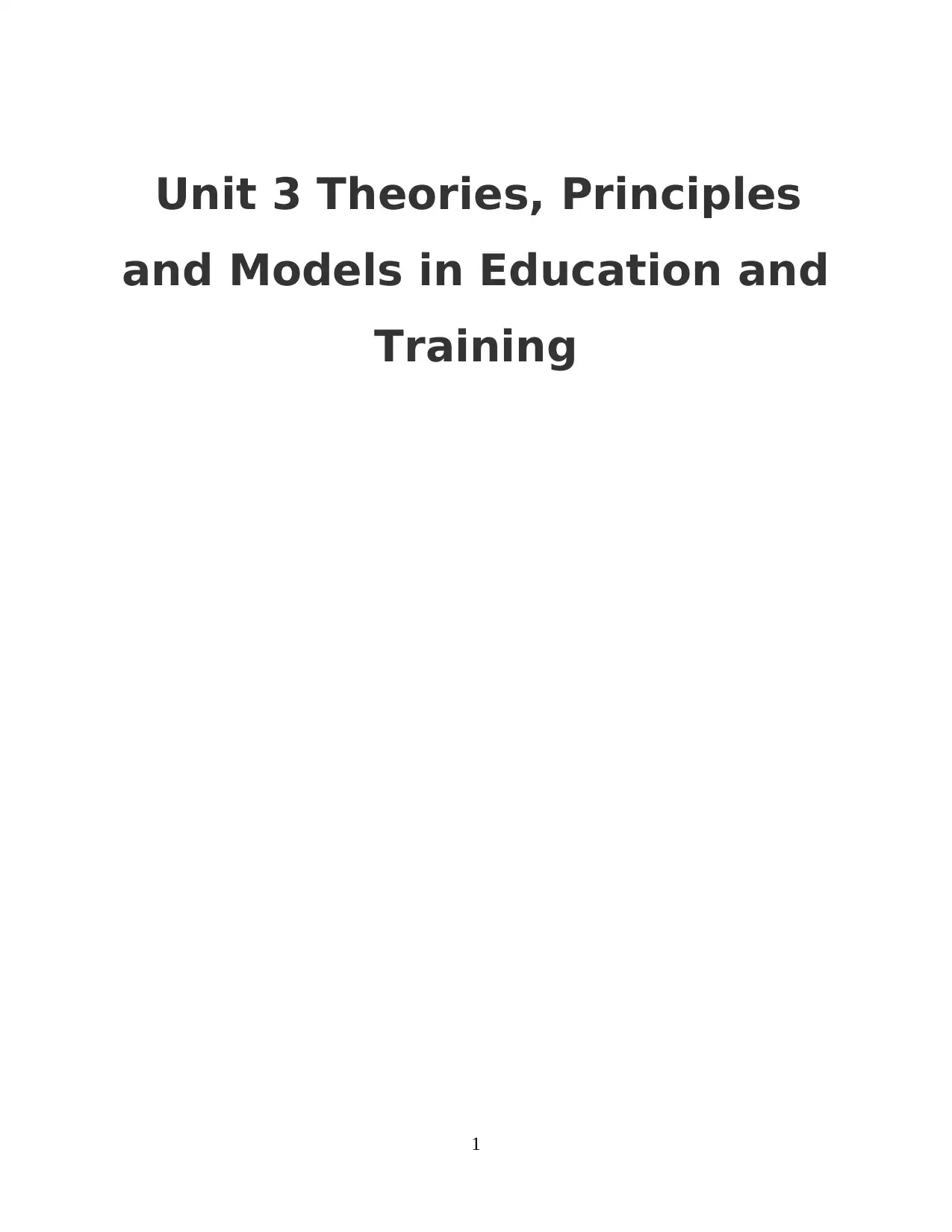
Unit 3 Theories, Principles
and Models in Education and
Training
1
and Models in Education and
Training
1
Secure Best Marks with AI Grader
Need help grading? Try our AI Grader for instant feedback on your assignments.
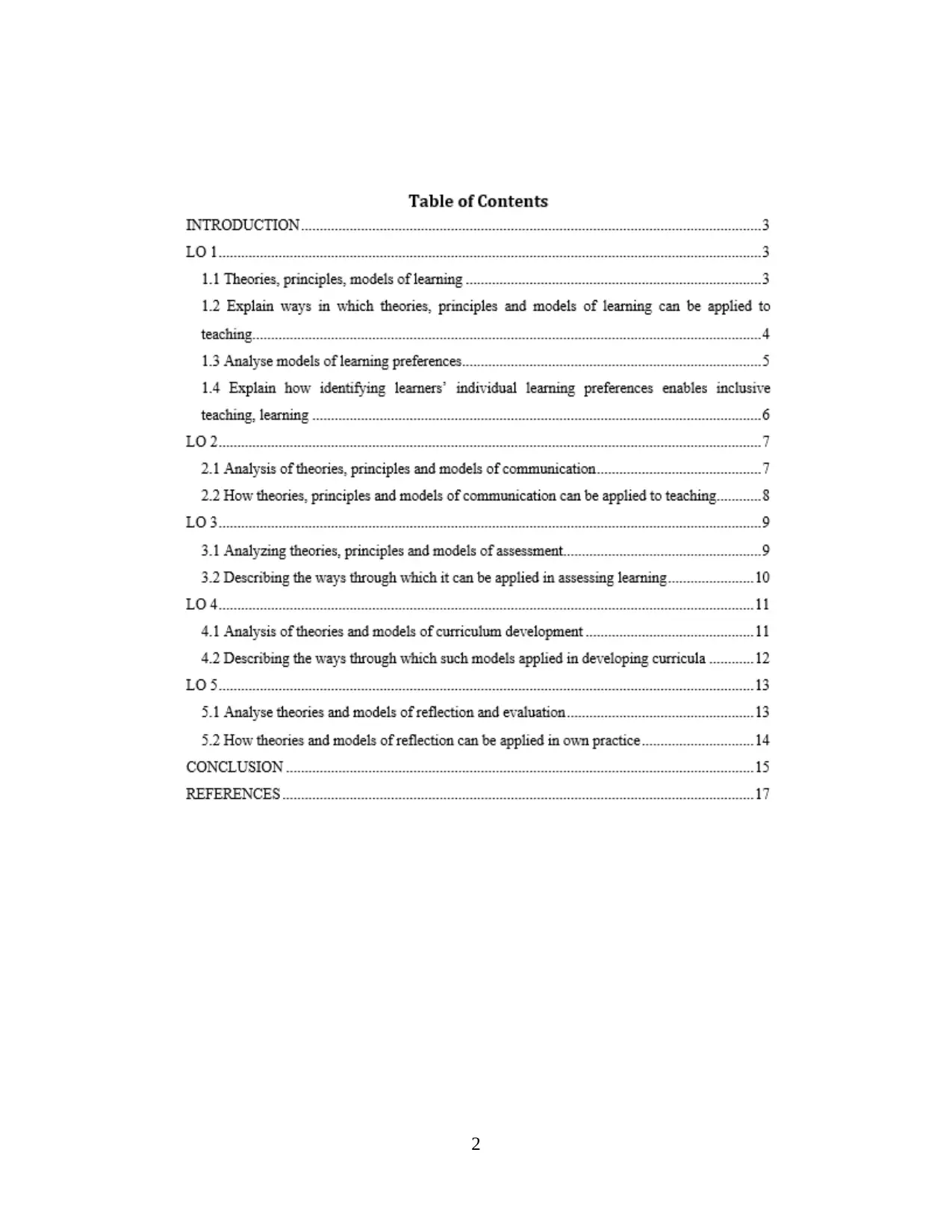
2
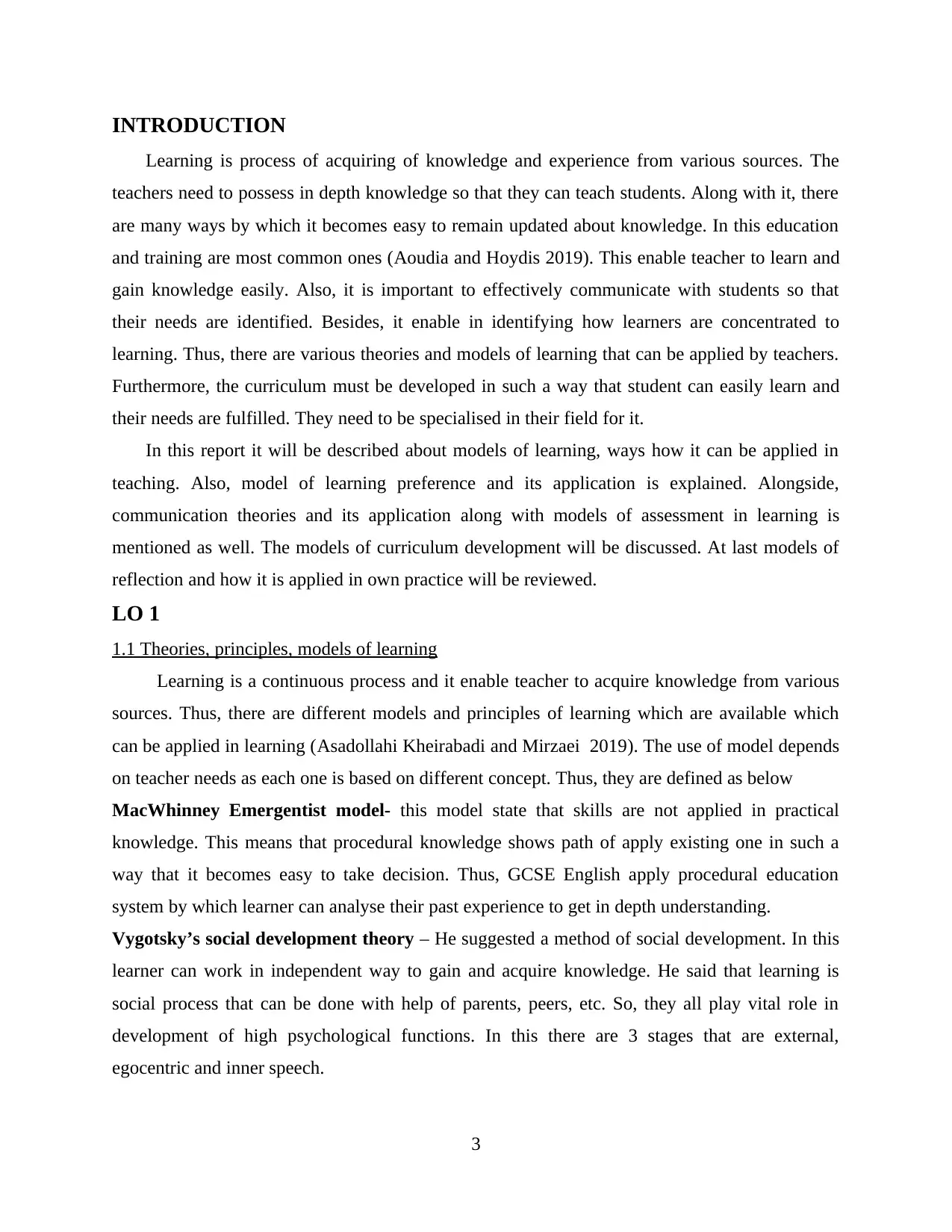
INTRODUCTION
Learning is process of acquiring of knowledge and experience from various sources. The
teachers need to possess in depth knowledge so that they can teach students. Along with it, there
are many ways by which it becomes easy to remain updated about knowledge. In this education
and training are most common ones (Aoudia and Hoydis 2019). This enable teacher to learn and
gain knowledge easily. Also, it is important to effectively communicate with students so that
their needs are identified. Besides, it enable in identifying how learners are concentrated to
learning. Thus, there are various theories and models of learning that can be applied by teachers.
Furthermore, the curriculum must be developed in such a way that student can easily learn and
their needs are fulfilled. They need to be specialised in their field for it.
In this report it will be described about models of learning, ways how it can be applied in
teaching. Also, model of learning preference and its application is explained. Alongside,
communication theories and its application along with models of assessment in learning is
mentioned as well. The models of curriculum development will be discussed. At last models of
reflection and how it is applied in own practice will be reviewed.
LO 1
1.1 Theories, principles, models of learning
Learning is a continuous process and it enable teacher to acquire knowledge from various
sources. Thus, there are different models and principles of learning which are available which
can be applied in learning (Asadollahi Kheirabadi and Mirzaei 2019). The use of model depends
on teacher needs as each one is based on different concept. Thus, they are defined as below
MacWhinney Emergentist model- this model state that skills are not applied in practical
knowledge. This means that procedural knowledge shows path of apply existing one in such a
way that it becomes easy to take decision. Thus, GCSE English apply procedural education
system by which learner can analyse their past experience to get in depth understanding.
Vygotsky’s social development theory – He suggested a method of social development. In this
learner can work in independent way to gain and acquire knowledge. He said that learning is
social process that can be done with help of parents, peers, etc. So, they all play vital role in
development of high psychological functions. In this there are 3 stages that are external,
egocentric and inner speech.
3
Learning is process of acquiring of knowledge and experience from various sources. The
teachers need to possess in depth knowledge so that they can teach students. Along with it, there
are many ways by which it becomes easy to remain updated about knowledge. In this education
and training are most common ones (Aoudia and Hoydis 2019). This enable teacher to learn and
gain knowledge easily. Also, it is important to effectively communicate with students so that
their needs are identified. Besides, it enable in identifying how learners are concentrated to
learning. Thus, there are various theories and models of learning that can be applied by teachers.
Furthermore, the curriculum must be developed in such a way that student can easily learn and
their needs are fulfilled. They need to be specialised in their field for it.
In this report it will be described about models of learning, ways how it can be applied in
teaching. Also, model of learning preference and its application is explained. Alongside,
communication theories and its application along with models of assessment in learning is
mentioned as well. The models of curriculum development will be discussed. At last models of
reflection and how it is applied in own practice will be reviewed.
LO 1
1.1 Theories, principles, models of learning
Learning is a continuous process and it enable teacher to acquire knowledge from various
sources. Thus, there are different models and principles of learning which are available which
can be applied in learning (Asadollahi Kheirabadi and Mirzaei 2019). The use of model depends
on teacher needs as each one is based on different concept. Thus, they are defined as below
MacWhinney Emergentist model- this model state that skills are not applied in practical
knowledge. This means that procedural knowledge shows path of apply existing one in such a
way that it becomes easy to take decision. Thus, GCSE English apply procedural education
system by which learner can analyse their past experience to get in depth understanding.
Vygotsky’s social development theory – He suggested a method of social development. In this
learner can work in independent way to gain and acquire knowledge. He said that learning is
social process that can be done with help of parents, peers, etc. So, they all play vital role in
development of high psychological functions. In this there are 3 stages that are external,
egocentric and inner speech.
3
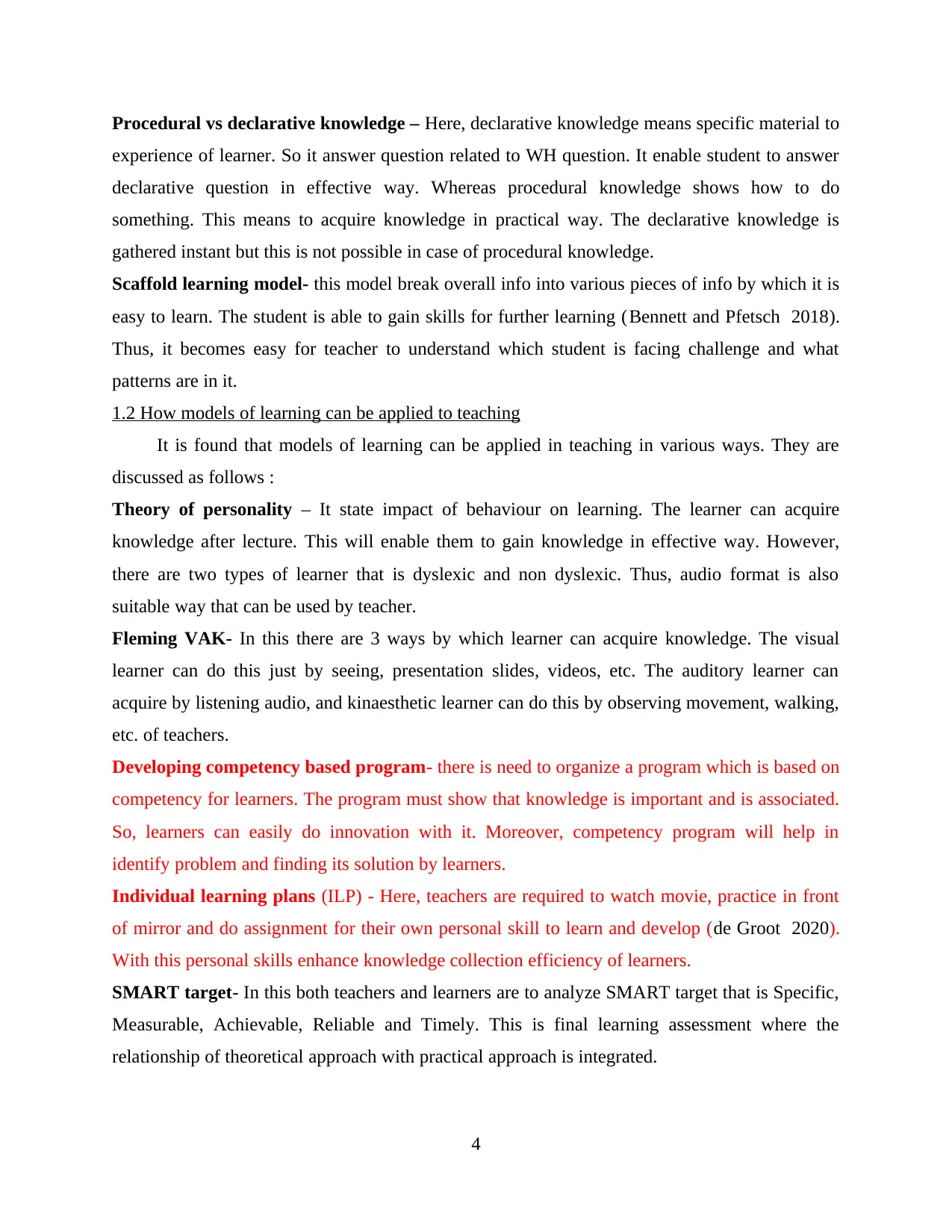
Procedural vs declarative knowledge – Here, declarative knowledge means specific material to
experience of learner. So it answer question related to WH question. It enable student to answer
declarative question in effective way. Whereas procedural knowledge shows how to do
something. This means to acquire knowledge in practical way. The declarative knowledge is
gathered instant but this is not possible in case of procedural knowledge.
Scaffold learning model- this model break overall info into various pieces of info by which it is
easy to learn. The student is able to gain skills for further learning (Bennett and Pfetsch 2018).
Thus, it becomes easy for teacher to understand which student is facing challenge and what
patterns are in it.
1.2 How models of learning can be applied to teaching
It is found that models of learning can be applied in teaching in various ways. They are
discussed as follows :
Theory of personality – It state impact of behaviour on learning. The learner can acquire
knowledge after lecture. This will enable them to gain knowledge in effective way. However,
there are two types of learner that is dyslexic and non dyslexic. Thus, audio format is also
suitable way that can be used by teacher.
Fleming VAK- In this there are 3 ways by which learner can acquire knowledge. The visual
learner can do this just by seeing, presentation slides, videos, etc. The auditory learner can
acquire by listening audio, and kinaesthetic learner can do this by observing movement, walking,
etc. of teachers.
Developing competency based program- there is need to organize a program which is based on
competency for learners. The program must show that knowledge is important and is associated.
So, learners can easily do innovation with it. Moreover, competency program will help in
identify problem and finding its solution by learners.
Individual learning plans (ILP) - Here, teachers are required to watch movie, practice in front
of mirror and do assignment for their own personal skill to learn and develop (de Groot 2020).
With this personal skills enhance knowledge collection efficiency of learners.
SMART target- In this both teachers and learners are to analyze SMART target that is Specific,
Measurable, Achievable, Reliable and Timely. This is final learning assessment where the
relationship of theoretical approach with practical approach is integrated.
4
experience of learner. So it answer question related to WH question. It enable student to answer
declarative question in effective way. Whereas procedural knowledge shows how to do
something. This means to acquire knowledge in practical way. The declarative knowledge is
gathered instant but this is not possible in case of procedural knowledge.
Scaffold learning model- this model break overall info into various pieces of info by which it is
easy to learn. The student is able to gain skills for further learning (Bennett and Pfetsch 2018).
Thus, it becomes easy for teacher to understand which student is facing challenge and what
patterns are in it.
1.2 How models of learning can be applied to teaching
It is found that models of learning can be applied in teaching in various ways. They are
discussed as follows :
Theory of personality – It state impact of behaviour on learning. The learner can acquire
knowledge after lecture. This will enable them to gain knowledge in effective way. However,
there are two types of learner that is dyslexic and non dyslexic. Thus, audio format is also
suitable way that can be used by teacher.
Fleming VAK- In this there are 3 ways by which learner can acquire knowledge. The visual
learner can do this just by seeing, presentation slides, videos, etc. The auditory learner can
acquire by listening audio, and kinaesthetic learner can do this by observing movement, walking,
etc. of teachers.
Developing competency based program- there is need to organize a program which is based on
competency for learners. The program must show that knowledge is important and is associated.
So, learners can easily do innovation with it. Moreover, competency program will help in
identify problem and finding its solution by learners.
Individual learning plans (ILP) - Here, teachers are required to watch movie, practice in front
of mirror and do assignment for their own personal skill to learn and develop (de Groot 2020).
With this personal skills enhance knowledge collection efficiency of learners.
SMART target- In this both teachers and learners are to analyze SMART target that is Specific,
Measurable, Achievable, Reliable and Timely. This is final learning assessment where the
relationship of theoretical approach with practical approach is integrated.
4
Secure Best Marks with AI Grader
Need help grading? Try our AI Grader for instant feedback on your assignments.
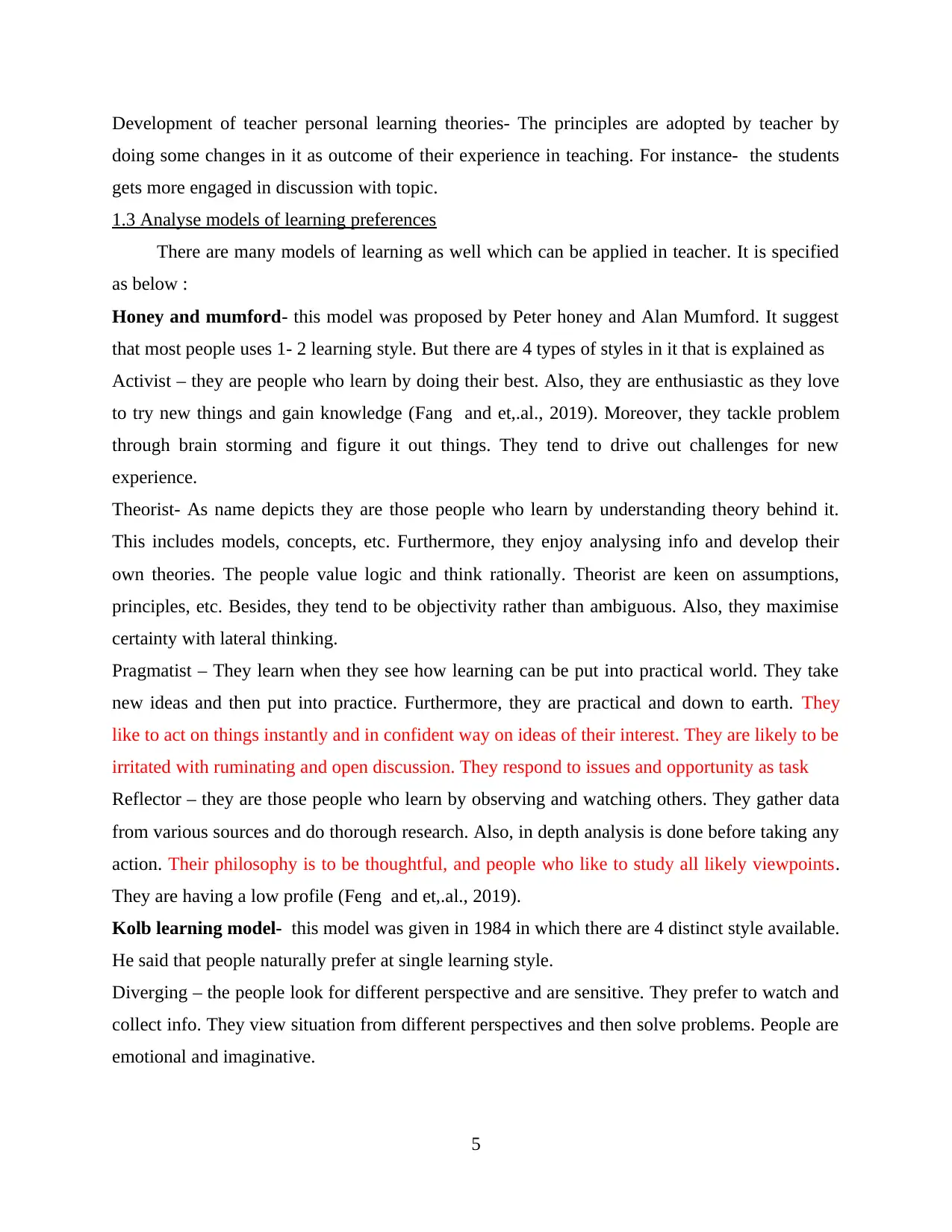
Development of teacher personal learning theories- The principles are adopted by teacher by
doing some changes in it as outcome of their experience in teaching. For instance- the students
gets more engaged in discussion with topic.
1.3 Analyse models of learning preferences
There are many models of learning as well which can be applied in teacher. It is specified
as below :
Honey and mumford- this model was proposed by Peter honey and Alan Mumford. It suggest
that most people uses 1- 2 learning style. But there are 4 types of styles in it that is explained as
Activist – they are people who learn by doing their best. Also, they are enthusiastic as they love
to try new things and gain knowledge (Fang and et,.al., 2019). Moreover, they tackle problem
through brain storming and figure it out things. They tend to drive out challenges for new
experience.
Theorist- As name depicts they are those people who learn by understanding theory behind it.
This includes models, concepts, etc. Furthermore, they enjoy analysing info and develop their
own theories. The people value logic and think rationally. Theorist are keen on assumptions,
principles, etc. Besides, they tend to be objectivity rather than ambiguous. Also, they maximise
certainty with lateral thinking.
Pragmatist – They learn when they see how learning can be put into practical world. They take
new ideas and then put into practice. Furthermore, they are practical and down to earth. They
like to act on things instantly and in confident way on ideas of their interest. They are likely to be
irritated with ruminating and open discussion. They respond to issues and opportunity as task
Reflector – they are those people who learn by observing and watching others. They gather data
from various sources and do thorough research. Also, in depth analysis is done before taking any
action. Their philosophy is to be thoughtful, and people who like to study all likely viewpoints.
They are having a low profile (Feng and et,.al., 2019).
Kolb learning model- this model was given in 1984 in which there are 4 distinct style available.
He said that people naturally prefer at single learning style.
Diverging – the people look for different perspective and are sensitive. They prefer to watch and
collect info. They view situation from different perspectives and then solve problems. People are
emotional and imaginative.
5
doing some changes in it as outcome of their experience in teaching. For instance- the students
gets more engaged in discussion with topic.
1.3 Analyse models of learning preferences
There are many models of learning as well which can be applied in teacher. It is specified
as below :
Honey and mumford- this model was proposed by Peter honey and Alan Mumford. It suggest
that most people uses 1- 2 learning style. But there are 4 types of styles in it that is explained as
Activist – they are people who learn by doing their best. Also, they are enthusiastic as they love
to try new things and gain knowledge (Fang and et,.al., 2019). Moreover, they tackle problem
through brain storming and figure it out things. They tend to drive out challenges for new
experience.
Theorist- As name depicts they are those people who learn by understanding theory behind it.
This includes models, concepts, etc. Furthermore, they enjoy analysing info and develop their
own theories. The people value logic and think rationally. Theorist are keen on assumptions,
principles, etc. Besides, they tend to be objectivity rather than ambiguous. Also, they maximise
certainty with lateral thinking.
Pragmatist – They learn when they see how learning can be put into practical world. They take
new ideas and then put into practice. Furthermore, they are practical and down to earth. They
like to act on things instantly and in confident way on ideas of their interest. They are likely to be
irritated with ruminating and open discussion. They respond to issues and opportunity as task
Reflector – they are those people who learn by observing and watching others. They gather data
from various sources and do thorough research. Also, in depth analysis is done before taking any
action. Their philosophy is to be thoughtful, and people who like to study all likely viewpoints.
They are having a low profile (Feng and et,.al., 2019).
Kolb learning model- this model was given in 1984 in which there are 4 distinct style available.
He said that people naturally prefer at single learning style.
Diverging – the people look for different perspective and are sensitive. They prefer to watch and
collect info. They view situation from different perspectives and then solve problems. People are
emotional and imaginative.
5
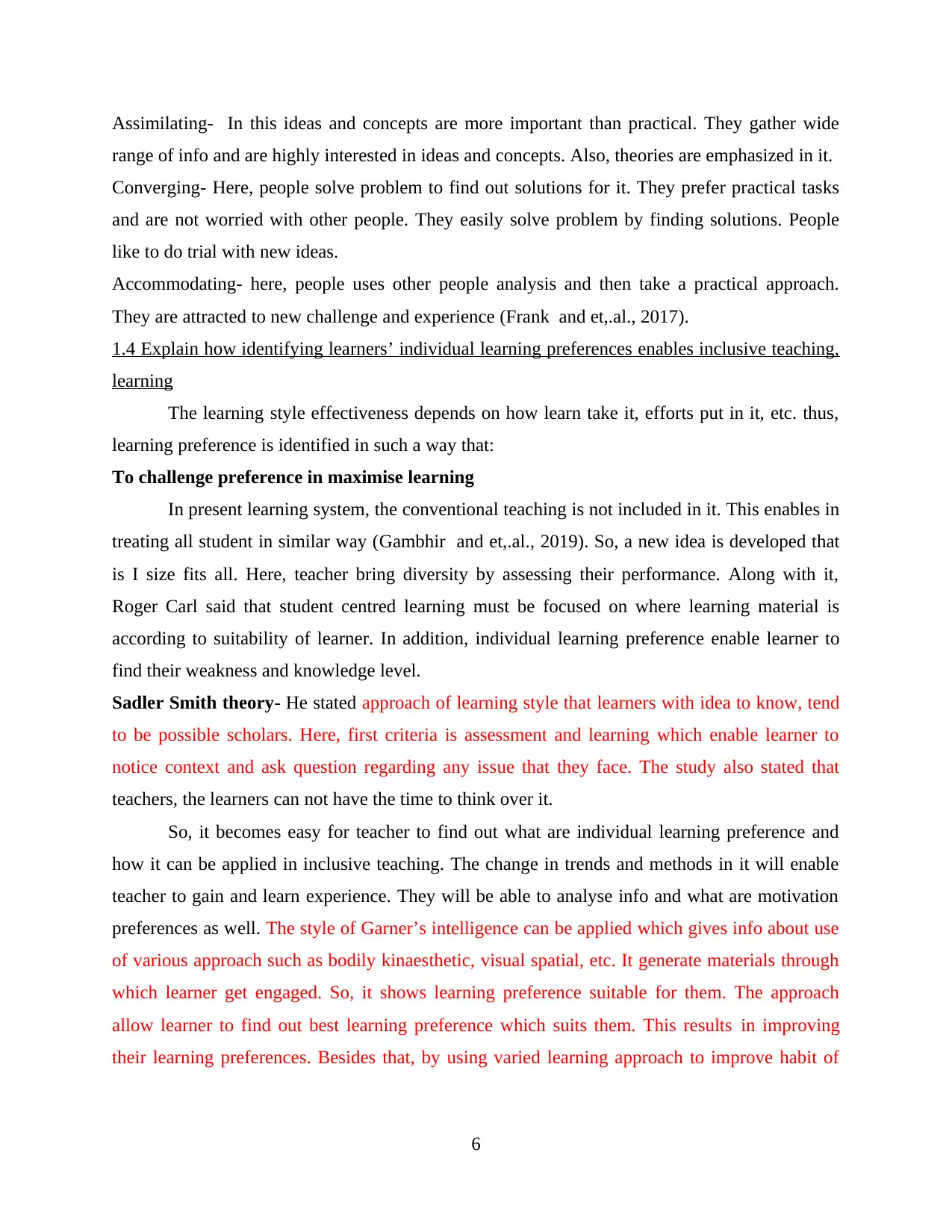
Assimilating- In this ideas and concepts are more important than practical. They gather wide
range of info and are highly interested in ideas and concepts. Also, theories are emphasized in it.
Converging- Here, people solve problem to find out solutions for it. They prefer practical tasks
and are not worried with other people. They easily solve problem by finding solutions. People
like to do trial with new ideas.
Accommodating- here, people uses other people analysis and then take a practical approach.
They are attracted to new challenge and experience (Frank and et,.al., 2017).
1.4 Explain how identifying learners’ individual learning preferences enables inclusive teaching,
learning
The learning style effectiveness depends on how learn take it, efforts put in it, etc. thus,
learning preference is identified in such a way that:
To challenge preference in maximise learning
In present learning system, the conventional teaching is not included in it. This enables in
treating all student in similar way (Gambhir and et,.al., 2019). So, a new idea is developed that
is I size fits all. Here, teacher bring diversity by assessing their performance. Along with it,
Roger Carl said that student centred learning must be focused on where learning material is
according to suitability of learner. In addition, individual learning preference enable learner to
find their weakness and knowledge level.
Sadler Smith theory- He stated approach of learning style that learners with idea to know, tend
to be possible scholars. Here, first criteria is assessment and learning which enable learner to
notice context and ask question regarding any issue that they face. The study also stated that
teachers, the learners can not have the time to think over it.
So, it becomes easy for teacher to find out what are individual learning preference and
how it can be applied in inclusive teaching. The change in trends and methods in it will enable
teacher to gain and learn experience. They will be able to analyse info and what are motivation
preferences as well. The style of Garner’s intelligence can be applied which gives info about use
of various approach such as bodily kinaesthetic, visual spatial, etc. It generate materials through
which learner get engaged. So, it shows learning preference suitable for them. The approach
allow learner to find out best learning preference which suits them. This results in improving
their learning preferences. Besides that, by using varied learning approach to improve habit of
6
range of info and are highly interested in ideas and concepts. Also, theories are emphasized in it.
Converging- Here, people solve problem to find out solutions for it. They prefer practical tasks
and are not worried with other people. They easily solve problem by finding solutions. People
like to do trial with new ideas.
Accommodating- here, people uses other people analysis and then take a practical approach.
They are attracted to new challenge and experience (Frank and et,.al., 2017).
1.4 Explain how identifying learners’ individual learning preferences enables inclusive teaching,
learning
The learning style effectiveness depends on how learn take it, efforts put in it, etc. thus,
learning preference is identified in such a way that:
To challenge preference in maximise learning
In present learning system, the conventional teaching is not included in it. This enables in
treating all student in similar way (Gambhir and et,.al., 2019). So, a new idea is developed that
is I size fits all. Here, teacher bring diversity by assessing their performance. Along with it,
Roger Carl said that student centred learning must be focused on where learning material is
according to suitability of learner. In addition, individual learning preference enable learner to
find their weakness and knowledge level.
Sadler Smith theory- He stated approach of learning style that learners with idea to know, tend
to be possible scholars. Here, first criteria is assessment and learning which enable learner to
notice context and ask question regarding any issue that they face. The study also stated that
teachers, the learners can not have the time to think over it.
So, it becomes easy for teacher to find out what are individual learning preference and
how it can be applied in inclusive teaching. The change in trends and methods in it will enable
teacher to gain and learn experience. They will be able to analyse info and what are motivation
preferences as well. The style of Garner’s intelligence can be applied which gives info about use
of various approach such as bodily kinaesthetic, visual spatial, etc. It generate materials through
which learner get engaged. So, it shows learning preference suitable for them. The approach
allow learner to find out best learning preference which suits them. This results in improving
their learning preferences. Besides that, by using varied learning approach to improve habit of
6
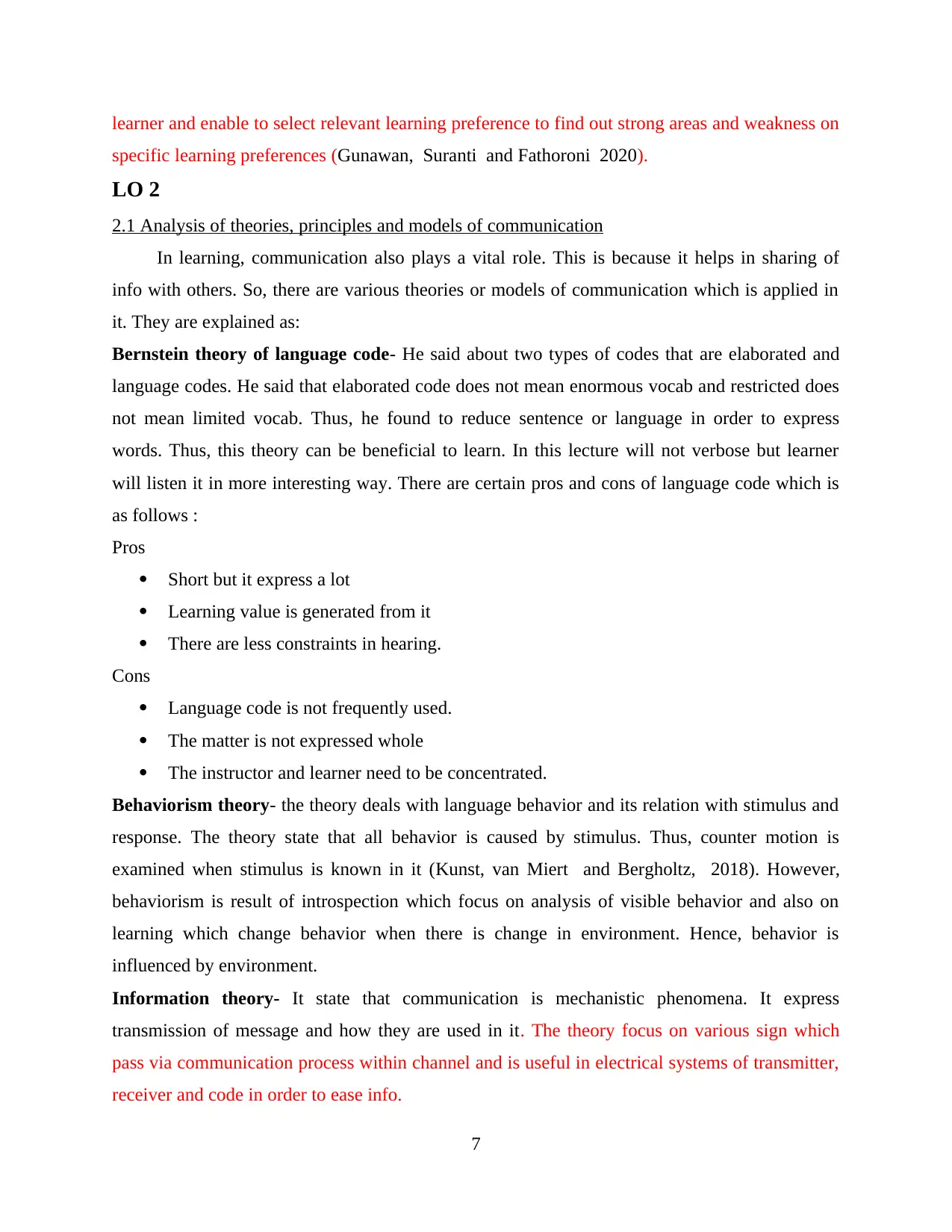
learner and enable to select relevant learning preference to find out strong areas and weakness on
specific learning preferences (Gunawan, Suranti and Fathoroni 2020).
LO 2
2.1 Analysis of theories, principles and models of communication
In learning, communication also plays a vital role. This is because it helps in sharing of
info with others. So, there are various theories or models of communication which is applied in
it. They are explained as:
Bernstein theory of language code- He said about two types of codes that are elaborated and
language codes. He said that elaborated code does not mean enormous vocab and restricted does
not mean limited vocab. Thus, he found to reduce sentence or language in order to express
words. Thus, this theory can be beneficial to learn. In this lecture will not verbose but learner
will listen it in more interesting way. There are certain pros and cons of language code which is
as follows :
Pros
Short but it express a lot
Learning value is generated from it
There are less constraints in hearing.
Cons
Language code is not frequently used.
The matter is not expressed whole
The instructor and learner need to be concentrated.
Behaviorism theory- the theory deals with language behavior and its relation with stimulus and
response. The theory state that all behavior is caused by stimulus. Thus, counter motion is
examined when stimulus is known in it (Kunst, van Miert and Bergholtz, 2018). However,
behaviorism is result of introspection which focus on analysis of visible behavior and also on
learning which change behavior when there is change in environment. Hence, behavior is
influenced by environment.
Information theory- It state that communication is mechanistic phenomena. It express
transmission of message and how they are used in it. The theory focus on various sign which
pass via communication process within channel and is useful in electrical systems of transmitter,
receiver and code in order to ease info.
7
specific learning preferences (Gunawan, Suranti and Fathoroni 2020).
LO 2
2.1 Analysis of theories, principles and models of communication
In learning, communication also plays a vital role. This is because it helps in sharing of
info with others. So, there are various theories or models of communication which is applied in
it. They are explained as:
Bernstein theory of language code- He said about two types of codes that are elaborated and
language codes. He said that elaborated code does not mean enormous vocab and restricted does
not mean limited vocab. Thus, he found to reduce sentence or language in order to express
words. Thus, this theory can be beneficial to learn. In this lecture will not verbose but learner
will listen it in more interesting way. There are certain pros and cons of language code which is
as follows :
Pros
Short but it express a lot
Learning value is generated from it
There are less constraints in hearing.
Cons
Language code is not frequently used.
The matter is not expressed whole
The instructor and learner need to be concentrated.
Behaviorism theory- the theory deals with language behavior and its relation with stimulus and
response. The theory state that all behavior is caused by stimulus. Thus, counter motion is
examined when stimulus is known in it (Kunst, van Miert and Bergholtz, 2018). However,
behaviorism is result of introspection which focus on analysis of visible behavior and also on
learning which change behavior when there is change in environment. Hence, behavior is
influenced by environment.
Information theory- It state that communication is mechanistic phenomena. It express
transmission of message and how they are used in it. The theory focus on various sign which
pass via communication process within channel and is useful in electrical systems of transmitter,
receiver and code in order to ease info.
7
Paraphrase This Document
Need a fresh take? Get an instant paraphrase of this document with our AI Paraphraser
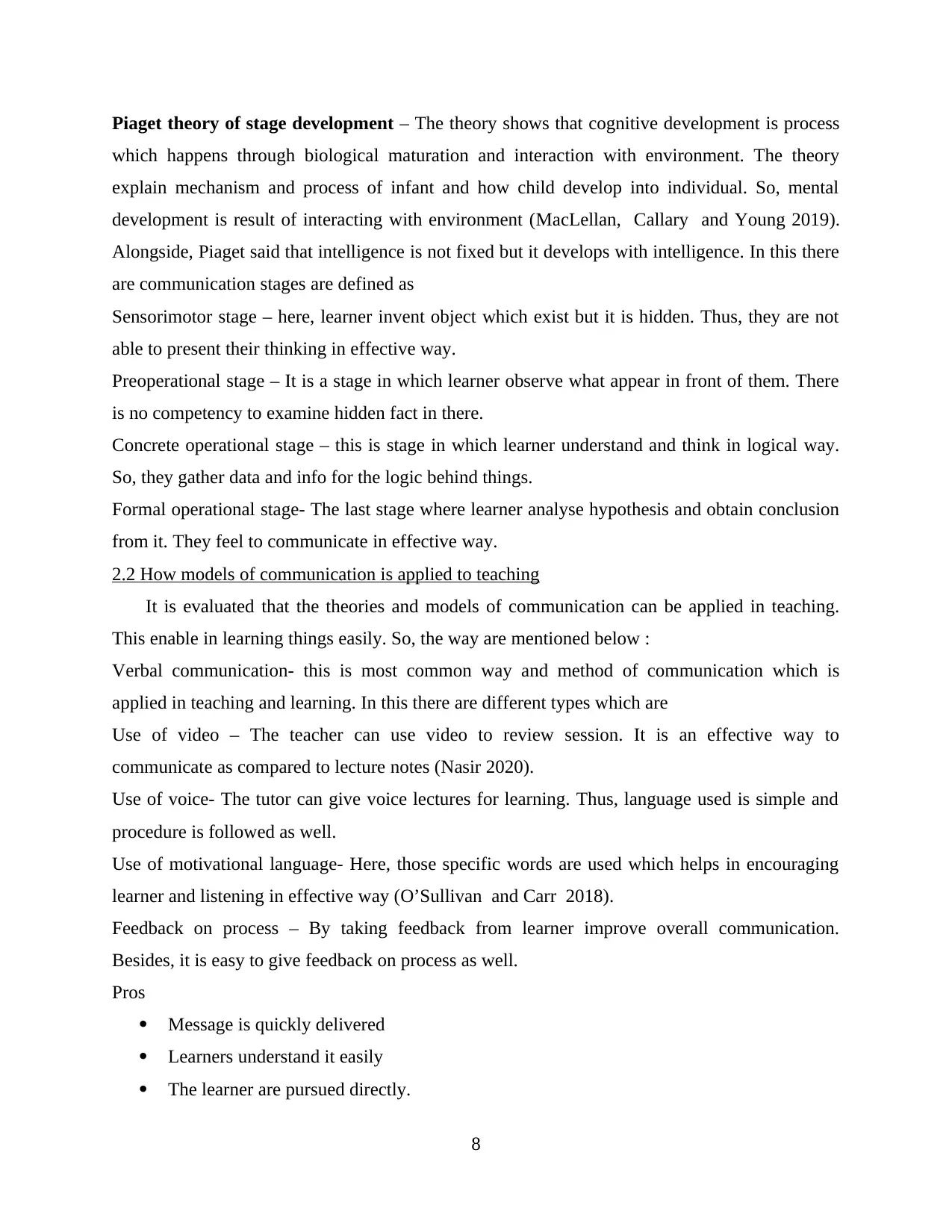
Piaget theory of stage development – The theory shows that cognitive development is process
which happens through biological maturation and interaction with environment. The theory
explain mechanism and process of infant and how child develop into individual. So, mental
development is result of interacting with environment (MacLellan, Callary and Young 2019).
Alongside, Piaget said that intelligence is not fixed but it develops with intelligence. In this there
are communication stages are defined as
Sensorimotor stage – here, learner invent object which exist but it is hidden. Thus, they are not
able to present their thinking in effective way.
Preoperational stage – It is a stage in which learner observe what appear in front of them. There
is no competency to examine hidden fact in there.
Concrete operational stage – this is stage in which learner understand and think in logical way.
So, they gather data and info for the logic behind things.
Formal operational stage- The last stage where learner analyse hypothesis and obtain conclusion
from it. They feel to communicate in effective way.
2.2 How models of communication is applied to teaching
It is evaluated that the theories and models of communication can be applied in teaching.
This enable in learning things easily. So, the way are mentioned below :
Verbal communication- this is most common way and method of communication which is
applied in teaching and learning. In this there are different types which are
Use of video – The teacher can use video to review session. It is an effective way to
communicate as compared to lecture notes (Nasir 2020).
Use of voice- The tutor can give voice lectures for learning. Thus, language used is simple and
procedure is followed as well.
Use of motivational language- Here, those specific words are used which helps in encouraging
learner and listening in effective way (O’Sullivan and Carr 2018).
Feedback on process – By taking feedback from learner improve overall communication.
Besides, it is easy to give feedback on process as well.
Pros
Message is quickly delivered
Learners understand it easily
The learner are pursued directly.
8
which happens through biological maturation and interaction with environment. The theory
explain mechanism and process of infant and how child develop into individual. So, mental
development is result of interacting with environment (MacLellan, Callary and Young 2019).
Alongside, Piaget said that intelligence is not fixed but it develops with intelligence. In this there
are communication stages are defined as
Sensorimotor stage – here, learner invent object which exist but it is hidden. Thus, they are not
able to present their thinking in effective way.
Preoperational stage – It is a stage in which learner observe what appear in front of them. There
is no competency to examine hidden fact in there.
Concrete operational stage – this is stage in which learner understand and think in logical way.
So, they gather data and info for the logic behind things.
Formal operational stage- The last stage where learner analyse hypothesis and obtain conclusion
from it. They feel to communicate in effective way.
2.2 How models of communication is applied to teaching
It is evaluated that the theories and models of communication can be applied in teaching.
This enable in learning things easily. So, the way are mentioned below :
Verbal communication- this is most common way and method of communication which is
applied in teaching and learning. In this there are different types which are
Use of video – The teacher can use video to review session. It is an effective way to
communicate as compared to lecture notes (Nasir 2020).
Use of voice- The tutor can give voice lectures for learning. Thus, language used is simple and
procedure is followed as well.
Use of motivational language- Here, those specific words are used which helps in encouraging
learner and listening in effective way (O’Sullivan and Carr 2018).
Feedback on process – By taking feedback from learner improve overall communication.
Besides, it is easy to give feedback on process as well.
Pros
Message is quickly delivered
Learners understand it easily
The learner are pursued directly.
8
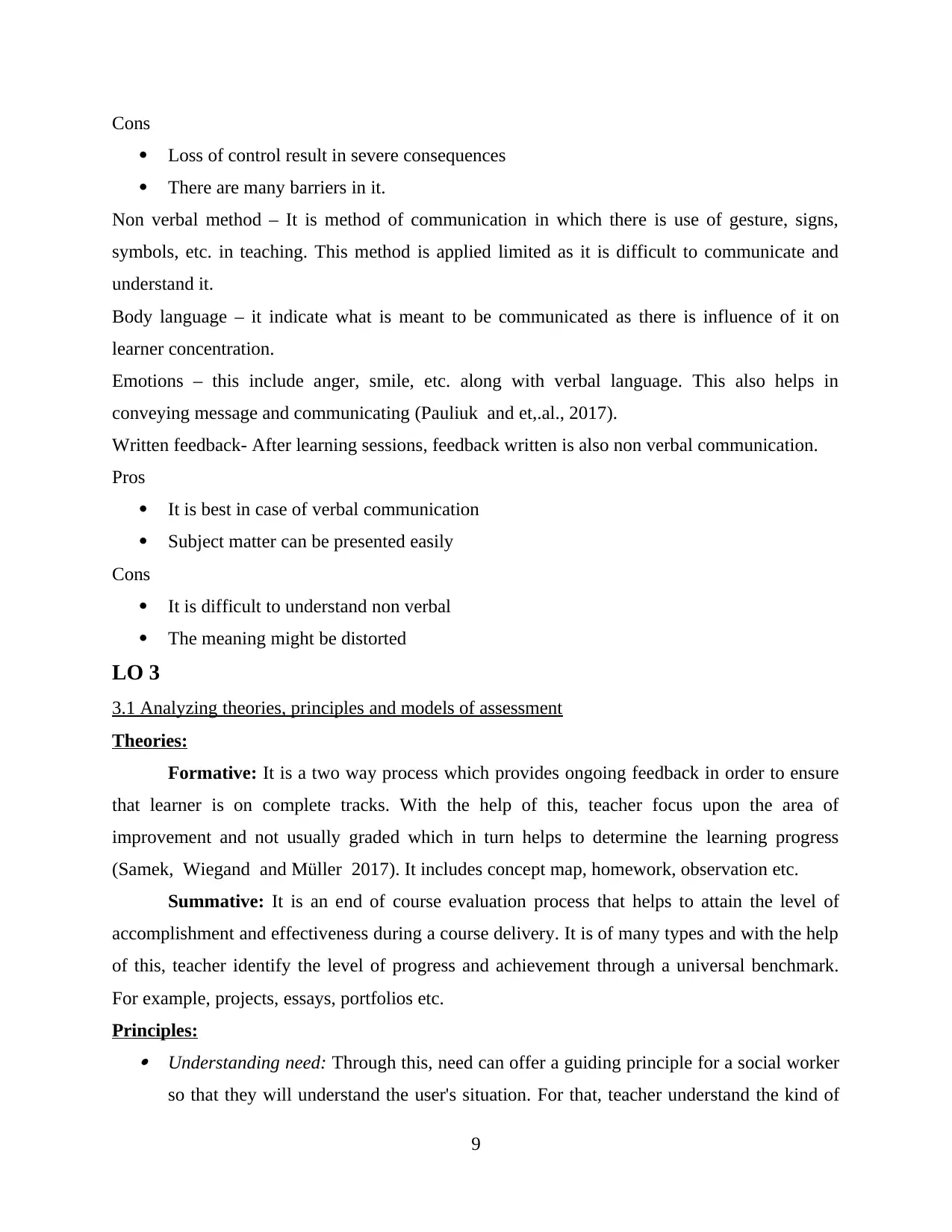
Cons
Loss of control result in severe consequences
There are many barriers in it.
Non verbal method – It is method of communication in which there is use of gesture, signs,
symbols, etc. in teaching. This method is applied limited as it is difficult to communicate and
understand it.
Body language – it indicate what is meant to be communicated as there is influence of it on
learner concentration.
Emotions – this include anger, smile, etc. along with verbal language. This also helps in
conveying message and communicating (Pauliuk and et,.al., 2017).
Written feedback- After learning sessions, feedback written is also non verbal communication.
Pros
It is best in case of verbal communication
Subject matter can be presented easily
Cons
It is difficult to understand non verbal
The meaning might be distorted
LO 3
3.1 Analyzing theories, principles and models of assessment
Theories:
Formative: It is a two way process which provides ongoing feedback in order to ensure
that learner is on complete tracks. With the help of this, teacher focus upon the area of
improvement and not usually graded which in turn helps to determine the learning progress
(Samek, Wiegand and Müller 2017). It includes concept map, homework, observation etc.
Summative: It is an end of course evaluation process that helps to attain the level of
accomplishment and effectiveness during a course delivery. It is of many types and with the help
of this, teacher identify the level of progress and achievement through a universal benchmark.
For example, projects, essays, portfolios etc.
Principles: Understanding need: Through this, need can offer a guiding principle for a social worker
so that they will understand the user's situation. For that, teacher understand the kind of
9
Loss of control result in severe consequences
There are many barriers in it.
Non verbal method – It is method of communication in which there is use of gesture, signs,
symbols, etc. in teaching. This method is applied limited as it is difficult to communicate and
understand it.
Body language – it indicate what is meant to be communicated as there is influence of it on
learner concentration.
Emotions – this include anger, smile, etc. along with verbal language. This also helps in
conveying message and communicating (Pauliuk and et,.al., 2017).
Written feedback- After learning sessions, feedback written is also non verbal communication.
Pros
It is best in case of verbal communication
Subject matter can be presented easily
Cons
It is difficult to understand non verbal
The meaning might be distorted
LO 3
3.1 Analyzing theories, principles and models of assessment
Theories:
Formative: It is a two way process which provides ongoing feedback in order to ensure
that learner is on complete tracks. With the help of this, teacher focus upon the area of
improvement and not usually graded which in turn helps to determine the learning progress
(Samek, Wiegand and Müller 2017). It includes concept map, homework, observation etc.
Summative: It is an end of course evaluation process that helps to attain the level of
accomplishment and effectiveness during a course delivery. It is of many types and with the help
of this, teacher identify the level of progress and achievement through a universal benchmark.
For example, projects, essays, portfolios etc.
Principles: Understanding need: Through this, need can offer a guiding principle for a social worker
so that they will understand the user's situation. For that, teacher understand the kind of
9
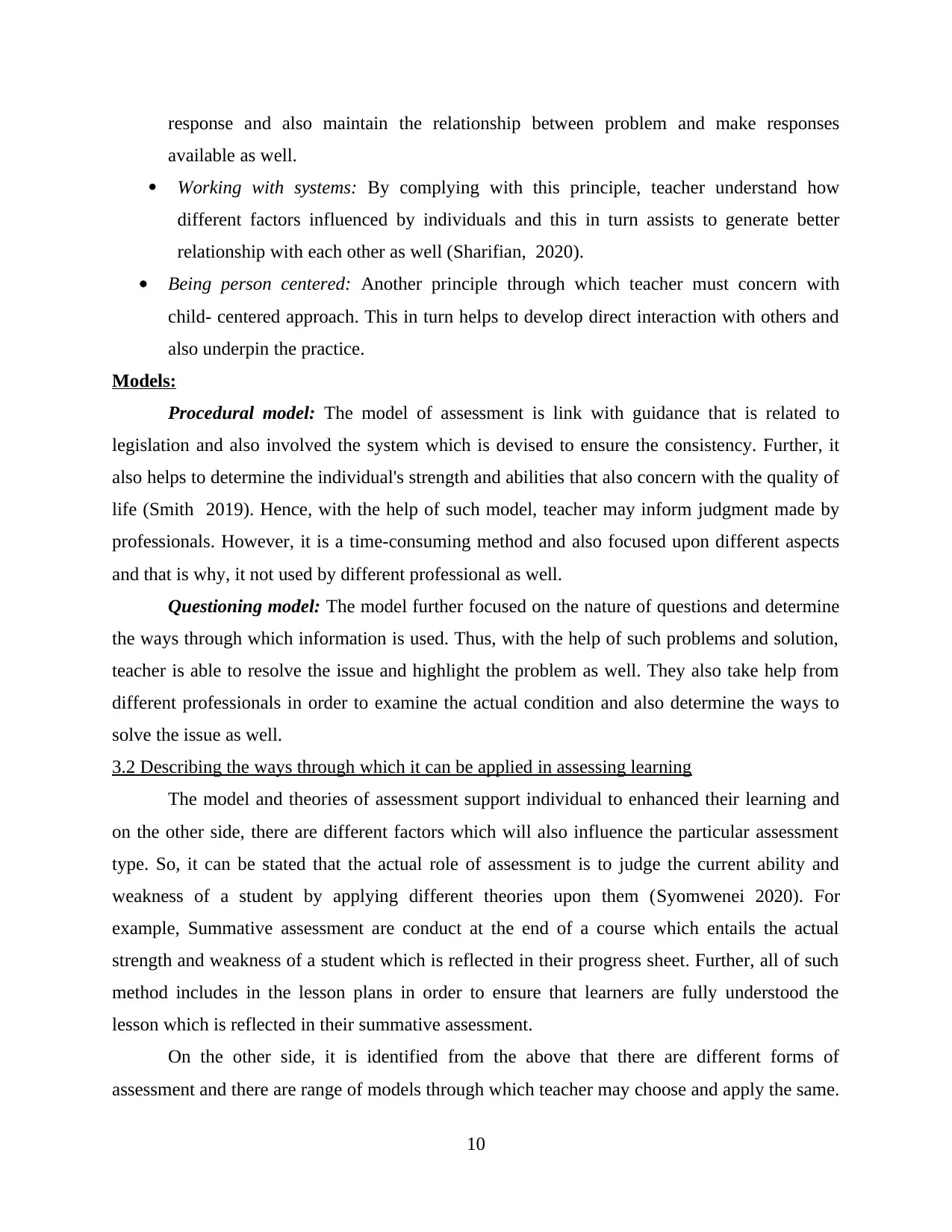
response and also maintain the relationship between problem and make responses
available as well.
Working with systems: By complying with this principle, teacher understand how
different factors influenced by individuals and this in turn assists to generate better
relationship with each other as well (Sharifian, 2020).
Being person centered: Another principle through which teacher must concern with
child- centered approach. This in turn helps to develop direct interaction with others and
also underpin the practice.
Models:
Procedural model: The model of assessment is link with guidance that is related to
legislation and also involved the system which is devised to ensure the consistency. Further, it
also helps to determine the individual's strength and abilities that also concern with the quality of
life (Smith 2019). Hence, with the help of such model, teacher may inform judgment made by
professionals. However, it is a time-consuming method and also focused upon different aspects
and that is why, it not used by different professional as well.
Questioning model: The model further focused on the nature of questions and determine
the ways through which information is used. Thus, with the help of such problems and solution,
teacher is able to resolve the issue and highlight the problem as well. They also take help from
different professionals in order to examine the actual condition and also determine the ways to
solve the issue as well.
3.2 Describing the ways through which it can be applied in assessing learning
The model and theories of assessment support individual to enhanced their learning and
on the other side, there are different factors which will also influence the particular assessment
type. So, it can be stated that the actual role of assessment is to judge the current ability and
weakness of a student by applying different theories upon them (Syomwenei 2020). For
example, Summative assessment are conduct at the end of a course which entails the actual
strength and weakness of a student which is reflected in their progress sheet. Further, all of such
method includes in the lesson plans in order to ensure that learners are fully understood the
lesson which is reflected in their summative assessment.
On the other side, it is identified from the above that there are different forms of
assessment and there are range of models through which teacher may choose and apply the same.
10
available as well.
Working with systems: By complying with this principle, teacher understand how
different factors influenced by individuals and this in turn assists to generate better
relationship with each other as well (Sharifian, 2020).
Being person centered: Another principle through which teacher must concern with
child- centered approach. This in turn helps to develop direct interaction with others and
also underpin the practice.
Models:
Procedural model: The model of assessment is link with guidance that is related to
legislation and also involved the system which is devised to ensure the consistency. Further, it
also helps to determine the individual's strength and abilities that also concern with the quality of
life (Smith 2019). Hence, with the help of such model, teacher may inform judgment made by
professionals. However, it is a time-consuming method and also focused upon different aspects
and that is why, it not used by different professional as well.
Questioning model: The model further focused on the nature of questions and determine
the ways through which information is used. Thus, with the help of such problems and solution,
teacher is able to resolve the issue and highlight the problem as well. They also take help from
different professionals in order to examine the actual condition and also determine the ways to
solve the issue as well.
3.2 Describing the ways through which it can be applied in assessing learning
The model and theories of assessment support individual to enhanced their learning and
on the other side, there are different factors which will also influence the particular assessment
type. So, it can be stated that the actual role of assessment is to judge the current ability and
weakness of a student by applying different theories upon them (Syomwenei 2020). For
example, Summative assessment are conduct at the end of a course which entails the actual
strength and weakness of a student which is reflected in their progress sheet. Further, all of such
method includes in the lesson plans in order to ensure that learners are fully understood the
lesson which is reflected in their summative assessment.
On the other side, it is identified from the above that there are different forms of
assessment and there are range of models through which teacher may choose and apply the same.
10
Secure Best Marks with AI Grader
Need help grading? Try our AI Grader for instant feedback on your assignments.
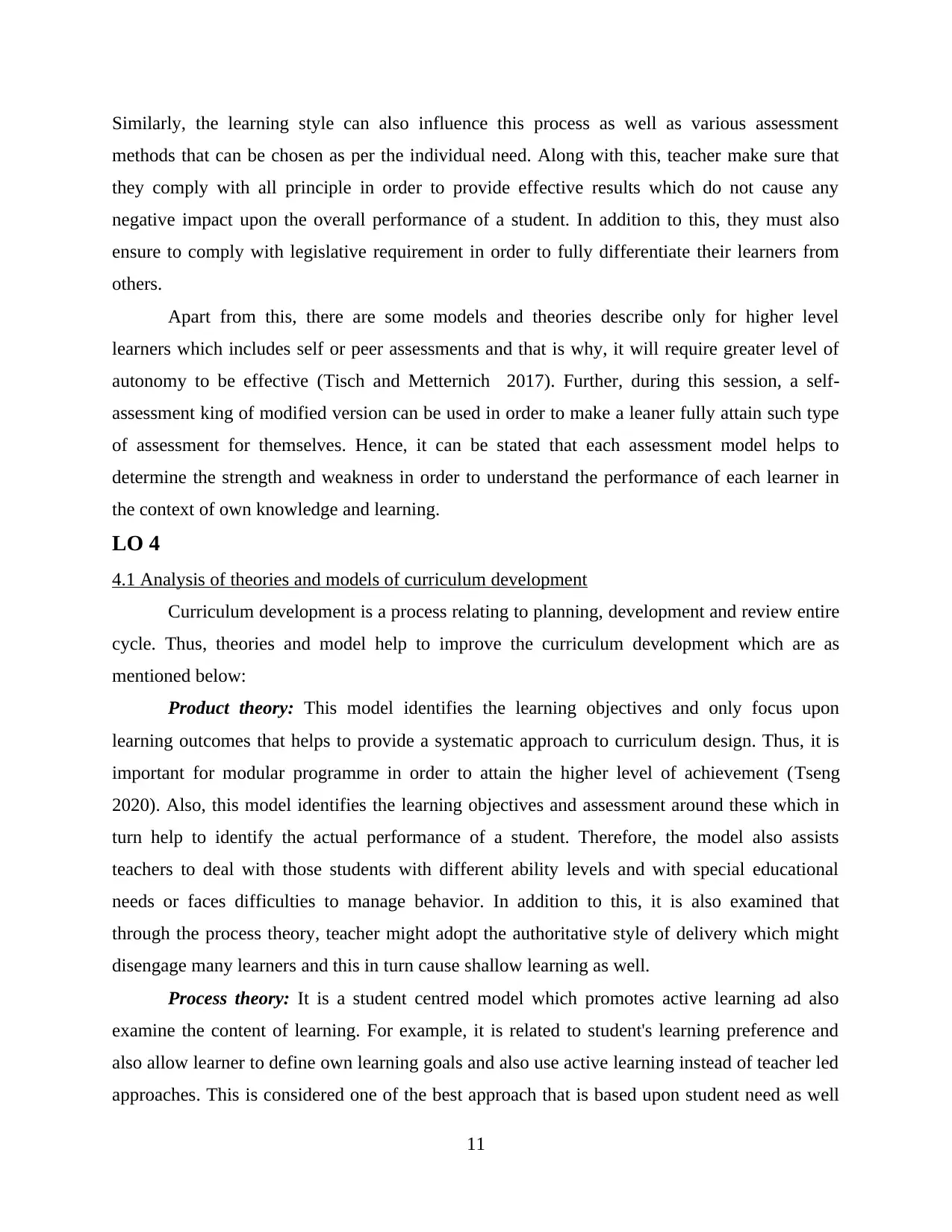
Similarly, the learning style can also influence this process as well as various assessment
methods that can be chosen as per the individual need. Along with this, teacher make sure that
they comply with all principle in order to provide effective results which do not cause any
negative impact upon the overall performance of a student. In addition to this, they must also
ensure to comply with legislative requirement in order to fully differentiate their learners from
others.
Apart from this, there are some models and theories describe only for higher level
learners which includes self or peer assessments and that is why, it will require greater level of
autonomy to be effective (Tisch and Metternich 2017). Further, during this session, a self-
assessment king of modified version can be used in order to make a leaner fully attain such type
of assessment for themselves. Hence, it can be stated that each assessment model helps to
determine the strength and weakness in order to understand the performance of each learner in
the context of own knowledge and learning.
LO 4
4.1 Analysis of theories and models of curriculum development
Curriculum development is a process relating to planning, development and review entire
cycle. Thus, theories and model help to improve the curriculum development which are as
mentioned below:
Product theory: This model identifies the learning objectives and only focus upon
learning outcomes that helps to provide a systematic approach to curriculum design. Thus, it is
important for modular programme in order to attain the higher level of achievement (Tseng
2020). Also, this model identifies the learning objectives and assessment around these which in
turn help to identify the actual performance of a student. Therefore, the model also assists
teachers to deal with those students with different ability levels and with special educational
needs or faces difficulties to manage behavior. In addition to this, it is also examined that
through the process theory, teacher might adopt the authoritative style of delivery which might
disengage many learners and this in turn cause shallow learning as well.
Process theory: It is a student centred model which promotes active learning ad also
examine the content of learning. For example, it is related to student's learning preference and
also allow learner to define own learning goals and also use active learning instead of teacher led
approaches. This is considered one of the best approach that is based upon student need as well
11
methods that can be chosen as per the individual need. Along with this, teacher make sure that
they comply with all principle in order to provide effective results which do not cause any
negative impact upon the overall performance of a student. In addition to this, they must also
ensure to comply with legislative requirement in order to fully differentiate their learners from
others.
Apart from this, there are some models and theories describe only for higher level
learners which includes self or peer assessments and that is why, it will require greater level of
autonomy to be effective (Tisch and Metternich 2017). Further, during this session, a self-
assessment king of modified version can be used in order to make a leaner fully attain such type
of assessment for themselves. Hence, it can be stated that each assessment model helps to
determine the strength and weakness in order to understand the performance of each learner in
the context of own knowledge and learning.
LO 4
4.1 Analysis of theories and models of curriculum development
Curriculum development is a process relating to planning, development and review entire
cycle. Thus, theories and model help to improve the curriculum development which are as
mentioned below:
Product theory: This model identifies the learning objectives and only focus upon
learning outcomes that helps to provide a systematic approach to curriculum design. Thus, it is
important for modular programme in order to attain the higher level of achievement (Tseng
2020). Also, this model identifies the learning objectives and assessment around these which in
turn help to identify the actual performance of a student. Therefore, the model also assists
teachers to deal with those students with different ability levels and with special educational
needs or faces difficulties to manage behavior. In addition to this, it is also examined that
through the process theory, teacher might adopt the authoritative style of delivery which might
disengage many learners and this in turn cause shallow learning as well.
Process theory: It is a student centred model which promotes active learning ad also
examine the content of learning. For example, it is related to student's learning preference and
also allow learner to define own learning goals and also use active learning instead of teacher led
approaches. This is considered one of the best approach that is based upon student need as well
11
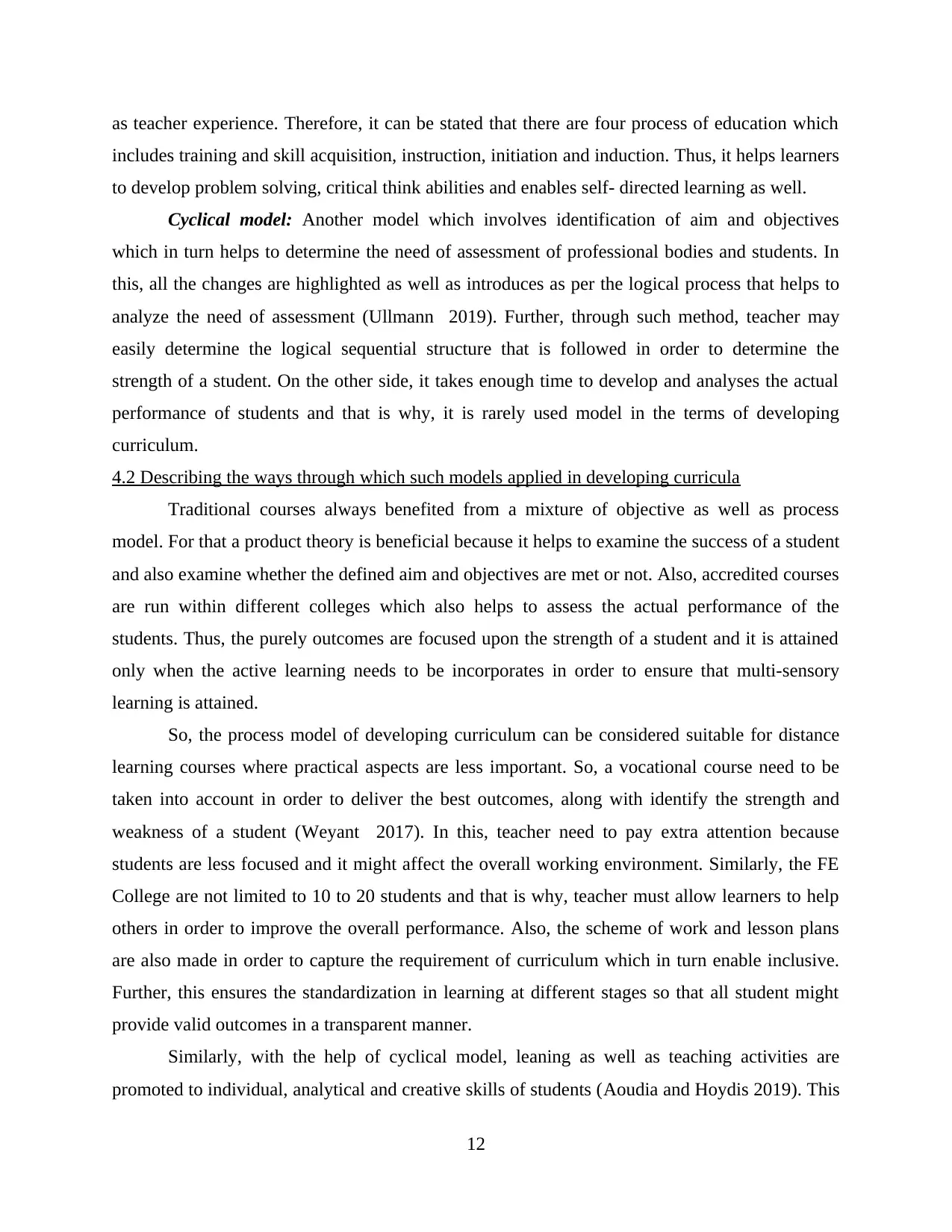
as teacher experience. Therefore, it can be stated that there are four process of education which
includes training and skill acquisition, instruction, initiation and induction. Thus, it helps learners
to develop problem solving, critical think abilities and enables self- directed learning as well.
Cyclical model: Another model which involves identification of aim and objectives
which in turn helps to determine the need of assessment of professional bodies and students. In
this, all the changes are highlighted as well as introduces as per the logical process that helps to
analyze the need of assessment (Ullmann 2019). Further, through such method, teacher may
easily determine the logical sequential structure that is followed in order to determine the
strength of a student. On the other side, it takes enough time to develop and analyses the actual
performance of students and that is why, it is rarely used model in the terms of developing
curriculum.
4.2 Describing the ways through which such models applied in developing curricula
Traditional courses always benefited from a mixture of objective as well as process
model. For that a product theory is beneficial because it helps to examine the success of a student
and also examine whether the defined aim and objectives are met or not. Also, accredited courses
are run within different colleges which also helps to assess the actual performance of the
students. Thus, the purely outcomes are focused upon the strength of a student and it is attained
only when the active learning needs to be incorporates in order to ensure that multi-sensory
learning is attained.
So, the process model of developing curriculum can be considered suitable for distance
learning courses where practical aspects are less important. So, a vocational course need to be
taken into account in order to deliver the best outcomes, along with identify the strength and
weakness of a student (Weyant 2017). In this, teacher need to pay extra attention because
students are less focused and it might affect the overall working environment. Similarly, the FE
College are not limited to 10 to 20 students and that is why, teacher must allow learners to help
others in order to improve the overall performance. Also, the scheme of work and lesson plans
are also made in order to capture the requirement of curriculum which in turn enable inclusive.
Further, this ensures the standardization in learning at different stages so that all student might
provide valid outcomes in a transparent manner.
Similarly, with the help of cyclical model, leaning as well as teaching activities are
promoted to individual, analytical and creative skills of students (Aoudia and Hoydis 2019). This
12
includes training and skill acquisition, instruction, initiation and induction. Thus, it helps learners
to develop problem solving, critical think abilities and enables self- directed learning as well.
Cyclical model: Another model which involves identification of aim and objectives
which in turn helps to determine the need of assessment of professional bodies and students. In
this, all the changes are highlighted as well as introduces as per the logical process that helps to
analyze the need of assessment (Ullmann 2019). Further, through such method, teacher may
easily determine the logical sequential structure that is followed in order to determine the
strength of a student. On the other side, it takes enough time to develop and analyses the actual
performance of students and that is why, it is rarely used model in the terms of developing
curriculum.
4.2 Describing the ways through which such models applied in developing curricula
Traditional courses always benefited from a mixture of objective as well as process
model. For that a product theory is beneficial because it helps to examine the success of a student
and also examine whether the defined aim and objectives are met or not. Also, accredited courses
are run within different colleges which also helps to assess the actual performance of the
students. Thus, the purely outcomes are focused upon the strength of a student and it is attained
only when the active learning needs to be incorporates in order to ensure that multi-sensory
learning is attained.
So, the process model of developing curriculum can be considered suitable for distance
learning courses where practical aspects are less important. So, a vocational course need to be
taken into account in order to deliver the best outcomes, along with identify the strength and
weakness of a student (Weyant 2017). In this, teacher need to pay extra attention because
students are less focused and it might affect the overall working environment. Similarly, the FE
College are not limited to 10 to 20 students and that is why, teacher must allow learners to help
others in order to improve the overall performance. Also, the scheme of work and lesson plans
are also made in order to capture the requirement of curriculum which in turn enable inclusive.
Further, this ensures the standardization in learning at different stages so that all student might
provide valid outcomes in a transparent manner.
Similarly, with the help of cyclical model, leaning as well as teaching activities are
promoted to individual, analytical and creative skills of students (Aoudia and Hoydis 2019). This
12

in turn help to examine the aim and objectives so that it do not cause any negative impact upon
the performance of a student which in turn leads to improve the performance as well. However, it
is also determined that each and every student have their own area of specialized and that is why,
it is depended upon them how they used and applied the same in order to attain their defined aim.
For that, both product and process theory support teacher to clearly defined their views so that
relevant outcomes will be generated.
LO 5
5.1 Analyse theories and models of reflection and evaluation
Reflective analysis enables to gain in depth knowledge of varied learning experiences
worked on among professional growth expertise functionally, which further generates new scale
goals among competent skills development. There are different theories and models of reflection
which can be applied by teacher to evaluate their own performance and experience. Thus, they
can use it to improve their own learning and practice. Hence, models are mentioned as :
Kolb model of reflection
Kolb model of reflection is one of the most commonly used reflective model where
concrete experience, reflective observation, abstract conceptualization and active experimenting
are the steps which enable to gain analysis (Asadollahi Kheirabadi and Mirzaei 2019). The
model enables individual to identify new skills aspects, strengths fundamentally and weaknesses
fundamentally towards operative knowledge in their career experiences. By reflective analysis,
in depth focus is generated on diverse paradigms towards competitive keen knowledge and new
range of innovation goals towards functional benchmarks. Evaluation by usage of reflective
model will generate functional diversity professionally towards new varied range of competent
scale operatives, which enables an individual to reach targets at specific time period. Reflective
analysis professionally synchronizes new range of ideas creatively, to be imperatively bringing
on new projects in shape by gaining mentoring. It can be also analyzed that reflective analysis
sinks on corporate growth functionally towards building new scale trained efficacy paradigms,
towards larger scale efficacy aspects informatively
Gibbs reflective cycle model
Gibbs reflective cycle model, which enhances creative diversity standards professionally among
competent scenarios within professional knowledge aspects to gain diverse experience.
Description, feelings, evaluation, conclusion and action are the steps which engage diverse
13
the performance of a student which in turn leads to improve the performance as well. However, it
is also determined that each and every student have their own area of specialized and that is why,
it is depended upon them how they used and applied the same in order to attain their defined aim.
For that, both product and process theory support teacher to clearly defined their views so that
relevant outcomes will be generated.
LO 5
5.1 Analyse theories and models of reflection and evaluation
Reflective analysis enables to gain in depth knowledge of varied learning experiences
worked on among professional growth expertise functionally, which further generates new scale
goals among competent skills development. There are different theories and models of reflection
which can be applied by teacher to evaluate their own performance and experience. Thus, they
can use it to improve their own learning and practice. Hence, models are mentioned as :
Kolb model of reflection
Kolb model of reflection is one of the most commonly used reflective model where
concrete experience, reflective observation, abstract conceptualization and active experimenting
are the steps which enable to gain analysis (Asadollahi Kheirabadi and Mirzaei 2019). The
model enables individual to identify new skills aspects, strengths fundamentally and weaknesses
fundamentally towards operative knowledge in their career experiences. By reflective analysis,
in depth focus is generated on diverse paradigms towards competitive keen knowledge and new
range of innovation goals towards functional benchmarks. Evaluation by usage of reflective
model will generate functional diversity professionally towards new varied range of competent
scale operatives, which enables an individual to reach targets at specific time period. Reflective
analysis professionally synchronizes new range of ideas creatively, to be imperatively bringing
on new projects in shape by gaining mentoring. It can be also analyzed that reflective analysis
sinks on corporate growth functionally towards building new scale trained efficacy paradigms,
towards larger scale efficacy aspects informatively
Gibbs reflective cycle model
Gibbs reflective cycle model, which enhances creative diversity standards professionally among
competent scenarios within professional knowledge aspects to gain diverse experience.
Description, feelings, evaluation, conclusion and action are the steps which engage diverse
13
Paraphrase This Document
Need a fresh take? Get an instant paraphrase of this document with our AI Paraphraser
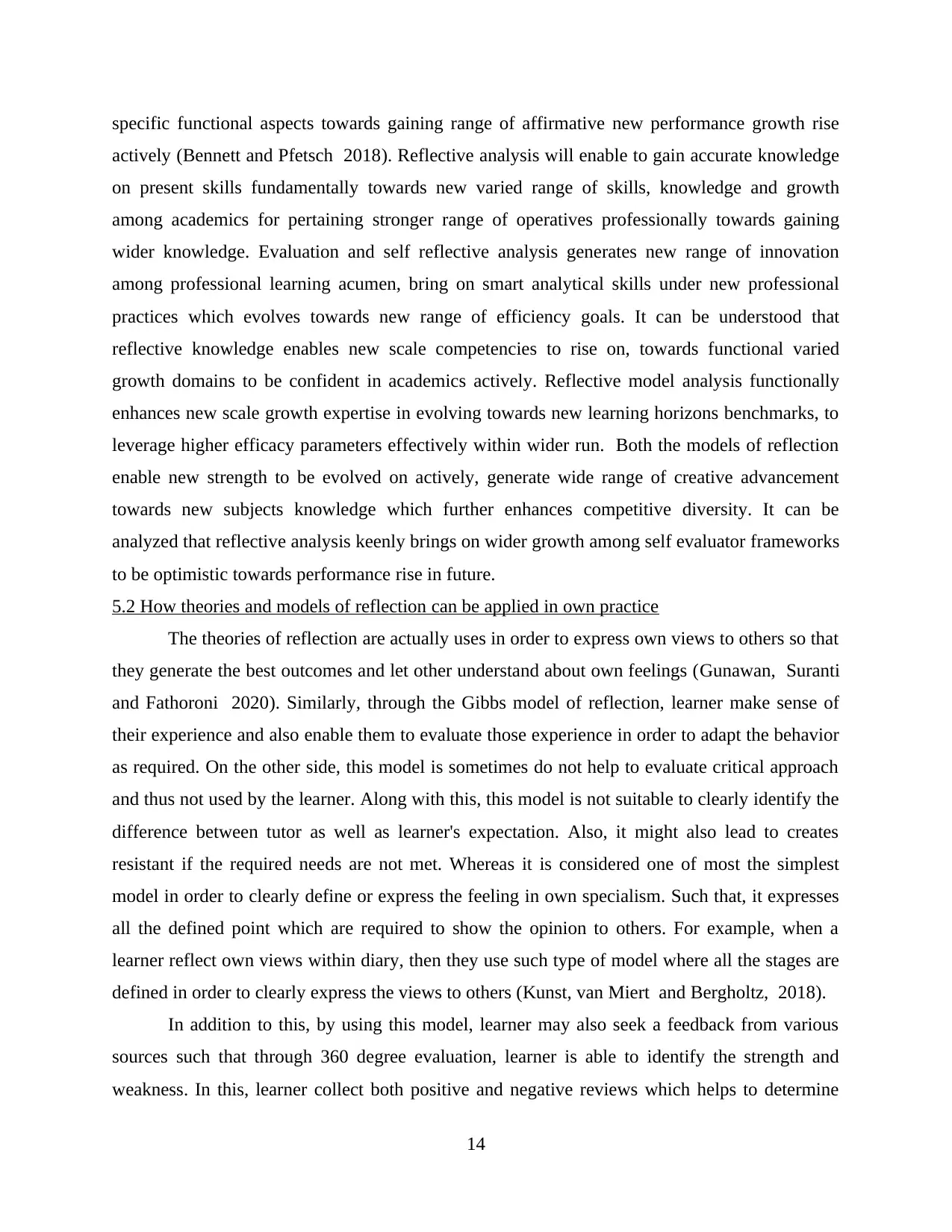
specific functional aspects towards gaining range of affirmative new performance growth rise
actively (Bennett and Pfetsch 2018). Reflective analysis will enable to gain accurate knowledge
on present skills fundamentally towards new varied range of skills, knowledge and growth
among academics for pertaining stronger range of operatives professionally towards gaining
wider knowledge. Evaluation and self reflective analysis generates new range of innovation
among professional learning acumen, bring on smart analytical skills under new professional
practices which evolves towards new range of efficiency goals. It can be understood that
reflective knowledge enables new scale competencies to rise on, towards functional varied
growth domains to be confident in academics actively. Reflective model analysis functionally
enhances new scale growth expertise in evolving towards new learning horizons benchmarks, to
leverage higher efficacy parameters effectively within wider run. Both the models of reflection
enable new strength to be evolved on actively, generate wide range of creative advancement
towards new subjects knowledge which further enhances competitive diversity. It can be
analyzed that reflective analysis keenly brings on wider growth among self evaluator frameworks
to be optimistic towards performance rise in future.
5.2 How theories and models of reflection can be applied in own practice
The theories of reflection are actually uses in order to express own views to others so that
they generate the best outcomes and let other understand about own feelings (Gunawan, Suranti
and Fathoroni 2020). Similarly, through the Gibbs model of reflection, learner make sense of
their experience and also enable them to evaluate those experience in order to adapt the behavior
as required. On the other side, this model is sometimes do not help to evaluate critical approach
and thus not used by the learner. Along with this, this model is not suitable to clearly identify the
difference between tutor as well as learner's expectation. Also, it might also lead to creates
resistant if the required needs are not met. Whereas it is considered one of most the simplest
model in order to clearly define or express the feeling in own specialism. Such that, it expresses
all the defined point which are required to show the opinion to others. For example, when a
learner reflect own views within diary, then they use such type of model where all the stages are
defined in order to clearly express the views to others (Kunst, van Miert and Bergholtz, 2018).
In addition to this, by using this model, learner may also seek a feedback from various
sources such that through 360 degree evaluation, learner is able to identify the strength and
weakness. In this, learner collect both positive and negative reviews which helps to determine
14
actively (Bennett and Pfetsch 2018). Reflective analysis will enable to gain accurate knowledge
on present skills fundamentally towards new varied range of skills, knowledge and growth
among academics for pertaining stronger range of operatives professionally towards gaining
wider knowledge. Evaluation and self reflective analysis generates new range of innovation
among professional learning acumen, bring on smart analytical skills under new professional
practices which evolves towards new range of efficiency goals. It can be understood that
reflective knowledge enables new scale competencies to rise on, towards functional varied
growth domains to be confident in academics actively. Reflective model analysis functionally
enhances new scale growth expertise in evolving towards new learning horizons benchmarks, to
leverage higher efficacy parameters effectively within wider run. Both the models of reflection
enable new strength to be evolved on actively, generate wide range of creative advancement
towards new subjects knowledge which further enhances competitive diversity. It can be
analyzed that reflective analysis keenly brings on wider growth among self evaluator frameworks
to be optimistic towards performance rise in future.
5.2 How theories and models of reflection can be applied in own practice
The theories of reflection are actually uses in order to express own views to others so that
they generate the best outcomes and let other understand about own feelings (Gunawan, Suranti
and Fathoroni 2020). Similarly, through the Gibbs model of reflection, learner make sense of
their experience and also enable them to evaluate those experience in order to adapt the behavior
as required. On the other side, this model is sometimes do not help to evaluate critical approach
and thus not used by the learner. Along with this, this model is not suitable to clearly identify the
difference between tutor as well as learner's expectation. Also, it might also lead to creates
resistant if the required needs are not met. Whereas it is considered one of most the simplest
model in order to clearly define or express the feeling in own specialism. Such that, it expresses
all the defined point which are required to show the opinion to others. For example, when a
learner reflect own views within diary, then they use such type of model where all the stages are
defined in order to clearly express the views to others (Kunst, van Miert and Bergholtz, 2018).
In addition to this, by using this model, learner may also seek a feedback from various
sources such that through 360 degree evaluation, learner is able to identify the strength and
weakness. In this, learner collect both positive and negative reviews which helps to determine
14
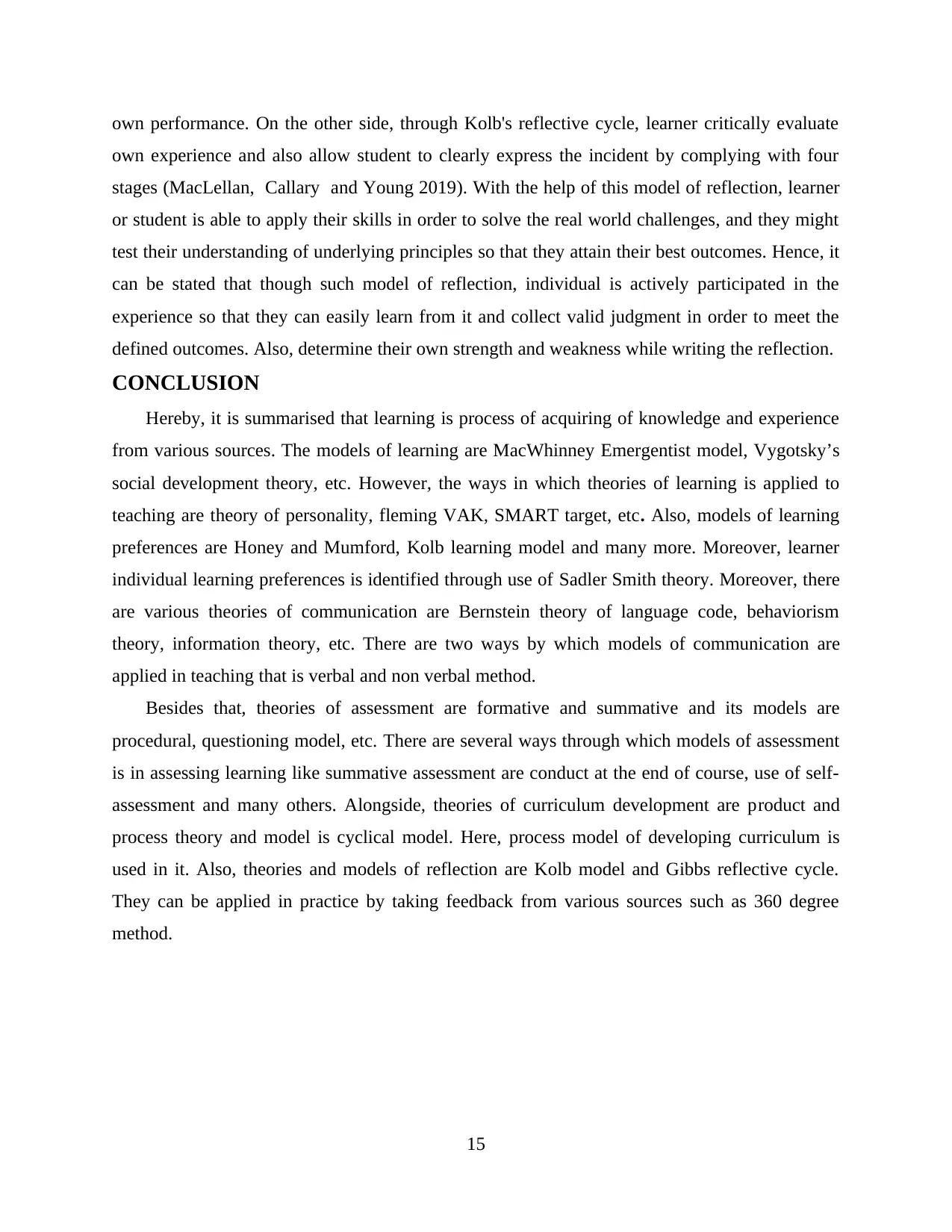
own performance. On the other side, through Kolb's reflective cycle, learner critically evaluate
own experience and also allow student to clearly express the incident by complying with four
stages (MacLellan, Callary and Young 2019). With the help of this model of reflection, learner
or student is able to apply their skills in order to solve the real world challenges, and they might
test their understanding of underlying principles so that they attain their best outcomes. Hence, it
can be stated that though such model of reflection, individual is actively participated in the
experience so that they can easily learn from it and collect valid judgment in order to meet the
defined outcomes. Also, determine their own strength and weakness while writing the reflection.
CONCLUSION
Hereby, it is summarised that learning is process of acquiring of knowledge and experience
from various sources. The models of learning are MacWhinney Emergentist model, Vygotsky’s
social development theory, etc. However, the ways in which theories of learning is applied to
teaching are theory of personality, fleming VAK, SMART target, etc. Also, models of learning
preferences are Honey and Mumford, Kolb learning model and many more. Moreover, learner
individual learning preferences is identified through use of Sadler Smith theory. Moreover, there
are various theories of communication are Bernstein theory of language code, behaviorism
theory, information theory, etc. There are two ways by which models of communication are
applied in teaching that is verbal and non verbal method.
Besides that, theories of assessment are formative and summative and its models are
procedural, questioning model, etc. There are several ways through which models of assessment
is in assessing learning like summative assessment are conduct at the end of course, use of self-
assessment and many others. Alongside, theories of curriculum development are product and
process theory and model is cyclical model. Here, process model of developing curriculum is
used in it. Also, theories and models of reflection are Kolb model and Gibbs reflective cycle.
They can be applied in practice by taking feedback from various sources such as 360 degree
method.
15
own experience and also allow student to clearly express the incident by complying with four
stages (MacLellan, Callary and Young 2019). With the help of this model of reflection, learner
or student is able to apply their skills in order to solve the real world challenges, and they might
test their understanding of underlying principles so that they attain their best outcomes. Hence, it
can be stated that though such model of reflection, individual is actively participated in the
experience so that they can easily learn from it and collect valid judgment in order to meet the
defined outcomes. Also, determine their own strength and weakness while writing the reflection.
CONCLUSION
Hereby, it is summarised that learning is process of acquiring of knowledge and experience
from various sources. The models of learning are MacWhinney Emergentist model, Vygotsky’s
social development theory, etc. However, the ways in which theories of learning is applied to
teaching are theory of personality, fleming VAK, SMART target, etc. Also, models of learning
preferences are Honey and Mumford, Kolb learning model and many more. Moreover, learner
individual learning preferences is identified through use of Sadler Smith theory. Moreover, there
are various theories of communication are Bernstein theory of language code, behaviorism
theory, information theory, etc. There are two ways by which models of communication are
applied in teaching that is verbal and non verbal method.
Besides that, theories of assessment are formative and summative and its models are
procedural, questioning model, etc. There are several ways through which models of assessment
is in assessing learning like summative assessment are conduct at the end of course, use of self-
assessment and many others. Alongside, theories of curriculum development are product and
process theory and model is cyclical model. Here, process model of developing curriculum is
used in it. Also, theories and models of reflection are Kolb model and Gibbs reflective cycle.
They can be applied in practice by taking feedback from various sources such as 360 degree
method.
15
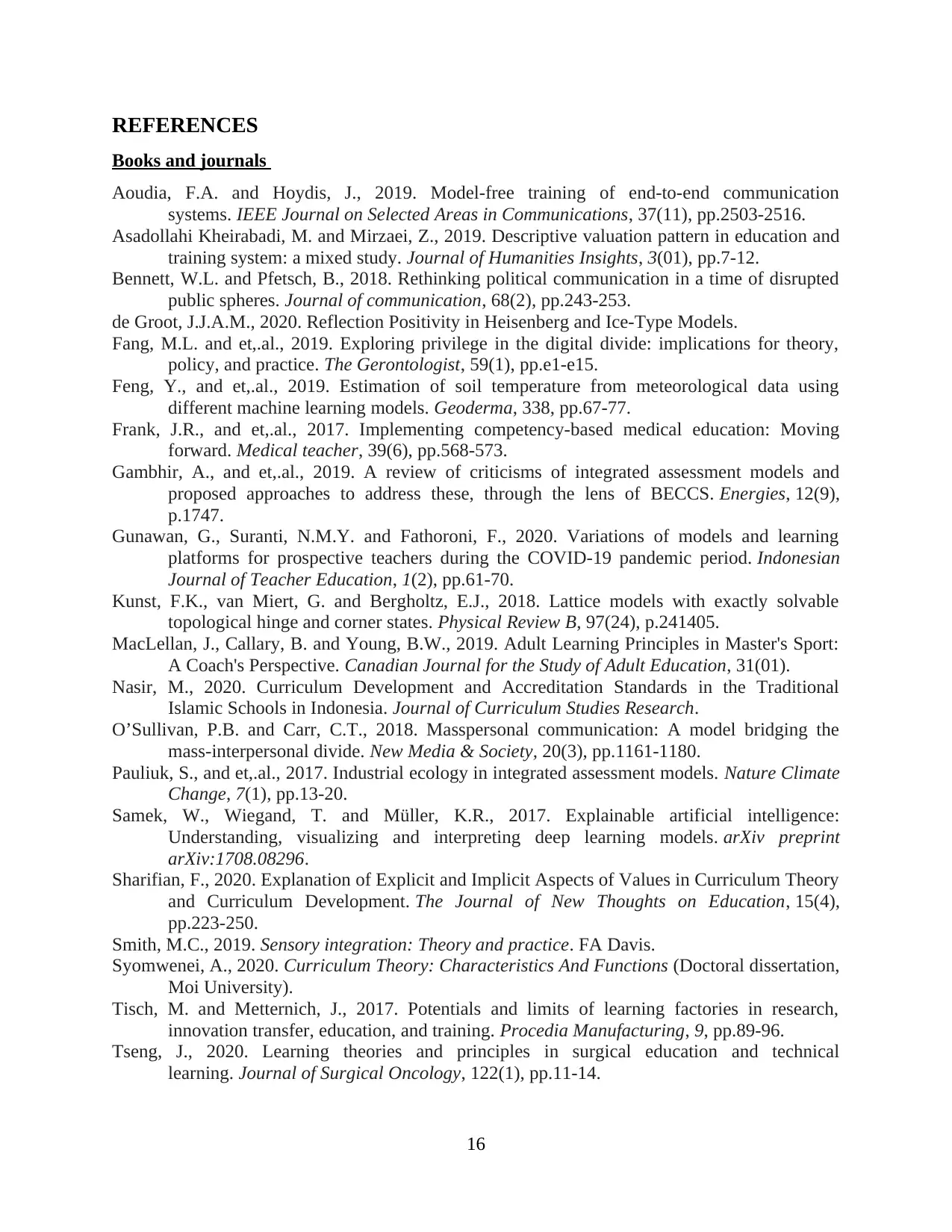
REFERENCES
Books and journals
Aoudia, F.A. and Hoydis, J., 2019. Model-free training of end-to-end communication
systems. IEEE Journal on Selected Areas in Communications, 37(11), pp.2503-2516.
Asadollahi Kheirabadi, M. and Mirzaei, Z., 2019. Descriptive valuation pattern in education and
training system: a mixed study. Journal of Humanities Insights, 3(01), pp.7-12.
Bennett, W.L. and Pfetsch, B., 2018. Rethinking political communication in a time of disrupted
public spheres. Journal of communication, 68(2), pp.243-253.
de Groot, J.J.A.M., 2020. Reflection Positivity in Heisenberg and Ice-Type Models.
Fang, M.L. and et,.al., 2019. Exploring privilege in the digital divide: implications for theory,
policy, and practice. The Gerontologist, 59(1), pp.e1-e15.
Feng, Y., and et,.al., 2019. Estimation of soil temperature from meteorological data using
different machine learning models. Geoderma, 338, pp.67-77.
Frank, J.R., and et,.al., 2017. Implementing competency-based medical education: Moving
forward. Medical teacher, 39(6), pp.568-573.
Gambhir, A., and et,.al., 2019. A review of criticisms of integrated assessment models and
proposed approaches to address these, through the lens of BECCS. Energies, 12(9),
p.1747.
Gunawan, G., Suranti, N.M.Y. and Fathoroni, F., 2020. Variations of models and learning
platforms for prospective teachers during the COVID-19 pandemic period. Indonesian
Journal of Teacher Education, 1(2), pp.61-70.
Kunst, F.K., van Miert, G. and Bergholtz, E.J., 2018. Lattice models with exactly solvable
topological hinge and corner states. Physical Review B, 97(24), p.241405.
MacLellan, J., Callary, B. and Young, B.W., 2019. Adult Learning Principles in Master's Sport:
A Coach's Perspective. Canadian Journal for the Study of Adult Education, 31(01).
Nasir, M., 2020. Curriculum Development and Accreditation Standards in the Traditional
Islamic Schools in Indonesia. Journal of Curriculum Studies Research.
O’Sullivan, P.B. and Carr, C.T., 2018. Masspersonal communication: A model bridging the
mass-interpersonal divide. New Media & Society, 20(3), pp.1161-1180.
Pauliuk, S., and et,.al., 2017. Industrial ecology in integrated assessment models. Nature Climate
Change, 7(1), pp.13-20.
Samek, W., Wiegand, T. and Müller, K.R., 2017. Explainable artificial intelligence:
Understanding, visualizing and interpreting deep learning models. arXiv preprint
arXiv:1708.08296.
Sharifian, F., 2020. Explanation of Explicit and Implicit Aspects of Values in Curriculum Theory
and Curriculum Development. The Journal of New Thoughts on Education, 15(4),
pp.223-250.
Smith, M.C., 2019. Sensory integration: Theory and practice. FA Davis.
Syomwenei, A., 2020. Curriculum Theory: Characteristics And Functions (Doctoral dissertation,
Moi University).
Tisch, M. and Metternich, J., 2017. Potentials and limits of learning factories in research,
innovation transfer, education, and training. Procedia Manufacturing, 9, pp.89-96.
Tseng, J., 2020. Learning theories and principles in surgical education and technical
learning. Journal of Surgical Oncology, 122(1), pp.11-14.
16
Books and journals
Aoudia, F.A. and Hoydis, J., 2019. Model-free training of end-to-end communication
systems. IEEE Journal on Selected Areas in Communications, 37(11), pp.2503-2516.
Asadollahi Kheirabadi, M. and Mirzaei, Z., 2019. Descriptive valuation pattern in education and
training system: a mixed study. Journal of Humanities Insights, 3(01), pp.7-12.
Bennett, W.L. and Pfetsch, B., 2018. Rethinking political communication in a time of disrupted
public spheres. Journal of communication, 68(2), pp.243-253.
de Groot, J.J.A.M., 2020. Reflection Positivity in Heisenberg and Ice-Type Models.
Fang, M.L. and et,.al., 2019. Exploring privilege in the digital divide: implications for theory,
policy, and practice. The Gerontologist, 59(1), pp.e1-e15.
Feng, Y., and et,.al., 2019. Estimation of soil temperature from meteorological data using
different machine learning models. Geoderma, 338, pp.67-77.
Frank, J.R., and et,.al., 2017. Implementing competency-based medical education: Moving
forward. Medical teacher, 39(6), pp.568-573.
Gambhir, A., and et,.al., 2019. A review of criticisms of integrated assessment models and
proposed approaches to address these, through the lens of BECCS. Energies, 12(9),
p.1747.
Gunawan, G., Suranti, N.M.Y. and Fathoroni, F., 2020. Variations of models and learning
platforms for prospective teachers during the COVID-19 pandemic period. Indonesian
Journal of Teacher Education, 1(2), pp.61-70.
Kunst, F.K., van Miert, G. and Bergholtz, E.J., 2018. Lattice models with exactly solvable
topological hinge and corner states. Physical Review B, 97(24), p.241405.
MacLellan, J., Callary, B. and Young, B.W., 2019. Adult Learning Principles in Master's Sport:
A Coach's Perspective. Canadian Journal for the Study of Adult Education, 31(01).
Nasir, M., 2020. Curriculum Development and Accreditation Standards in the Traditional
Islamic Schools in Indonesia. Journal of Curriculum Studies Research.
O’Sullivan, P.B. and Carr, C.T., 2018. Masspersonal communication: A model bridging the
mass-interpersonal divide. New Media & Society, 20(3), pp.1161-1180.
Pauliuk, S., and et,.al., 2017. Industrial ecology in integrated assessment models. Nature Climate
Change, 7(1), pp.13-20.
Samek, W., Wiegand, T. and Müller, K.R., 2017. Explainable artificial intelligence:
Understanding, visualizing and interpreting deep learning models. arXiv preprint
arXiv:1708.08296.
Sharifian, F., 2020. Explanation of Explicit and Implicit Aspects of Values in Curriculum Theory
and Curriculum Development. The Journal of New Thoughts on Education, 15(4),
pp.223-250.
Smith, M.C., 2019. Sensory integration: Theory and practice. FA Davis.
Syomwenei, A., 2020. Curriculum Theory: Characteristics And Functions (Doctoral dissertation,
Moi University).
Tisch, M. and Metternich, J., 2017. Potentials and limits of learning factories in research,
innovation transfer, education, and training. Procedia Manufacturing, 9, pp.89-96.
Tseng, J., 2020. Learning theories and principles in surgical education and technical
learning. Journal of Surgical Oncology, 122(1), pp.11-14.
16
Secure Best Marks with AI Grader
Need help grading? Try our AI Grader for instant feedback on your assignments.
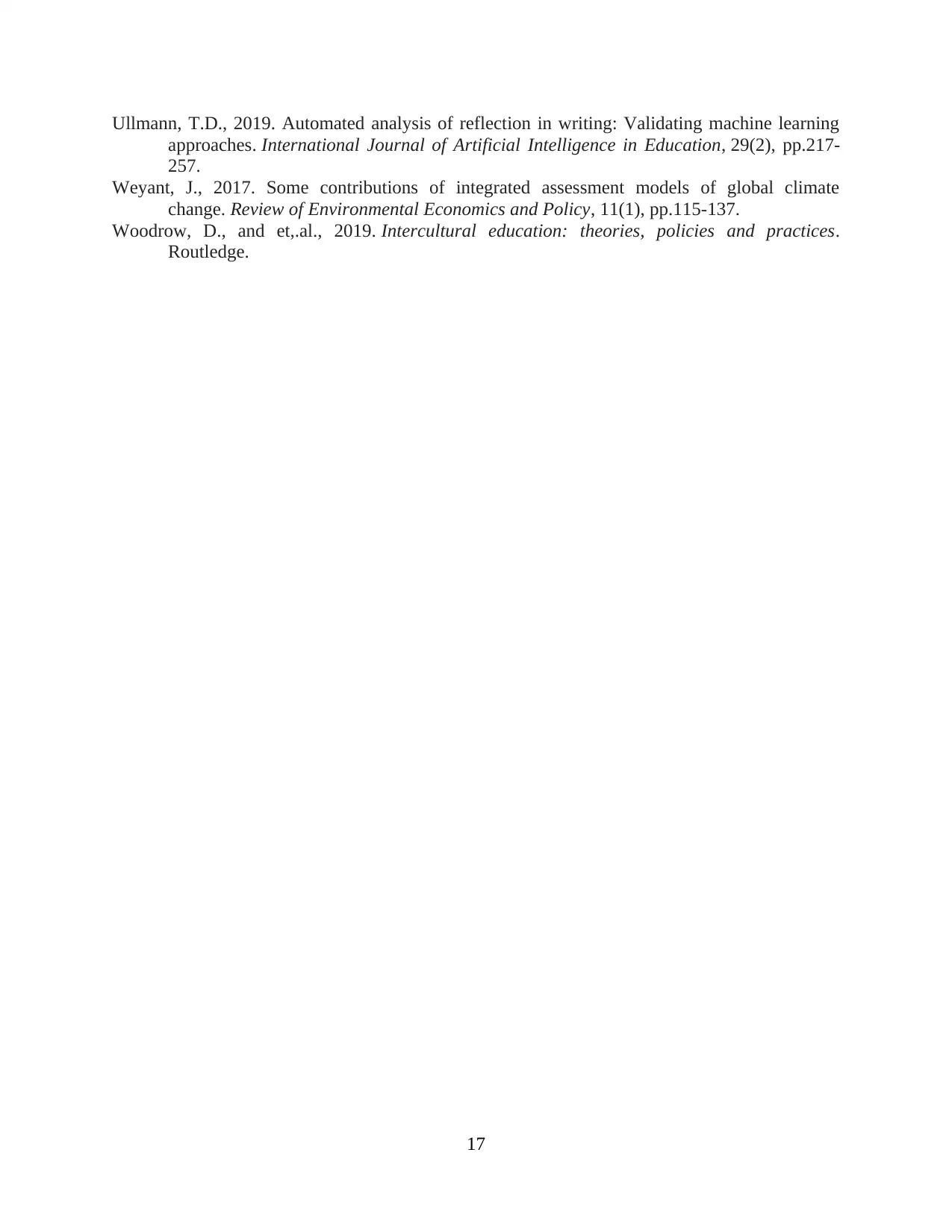
Ullmann, T.D., 2019. Automated analysis of reflection in writing: Validating machine learning
approaches. International Journal of Artificial Intelligence in Education, 29(2), pp.217-
257.
Weyant, J., 2017. Some contributions of integrated assessment models of global climate
change. Review of Environmental Economics and Policy, 11(1), pp.115-137.
Woodrow, D., and et,.al., 2019. Intercultural education: theories, policies and practices.
Routledge.
17
approaches. International Journal of Artificial Intelligence in Education, 29(2), pp.217-
257.
Weyant, J., 2017. Some contributions of integrated assessment models of global climate
change. Review of Environmental Economics and Policy, 11(1), pp.115-137.
Woodrow, D., and et,.al., 2019. Intercultural education: theories, policies and practices.
Routledge.
17
1 out of 17
Related Documents
Your All-in-One AI-Powered Toolkit for Academic Success.
+13062052269
info@desklib.com
Available 24*7 on WhatsApp / Email
![[object Object]](/_next/static/media/star-bottom.7253800d.svg)
Unlock your academic potential
© 2024 | Zucol Services PVT LTD | All rights reserved.



